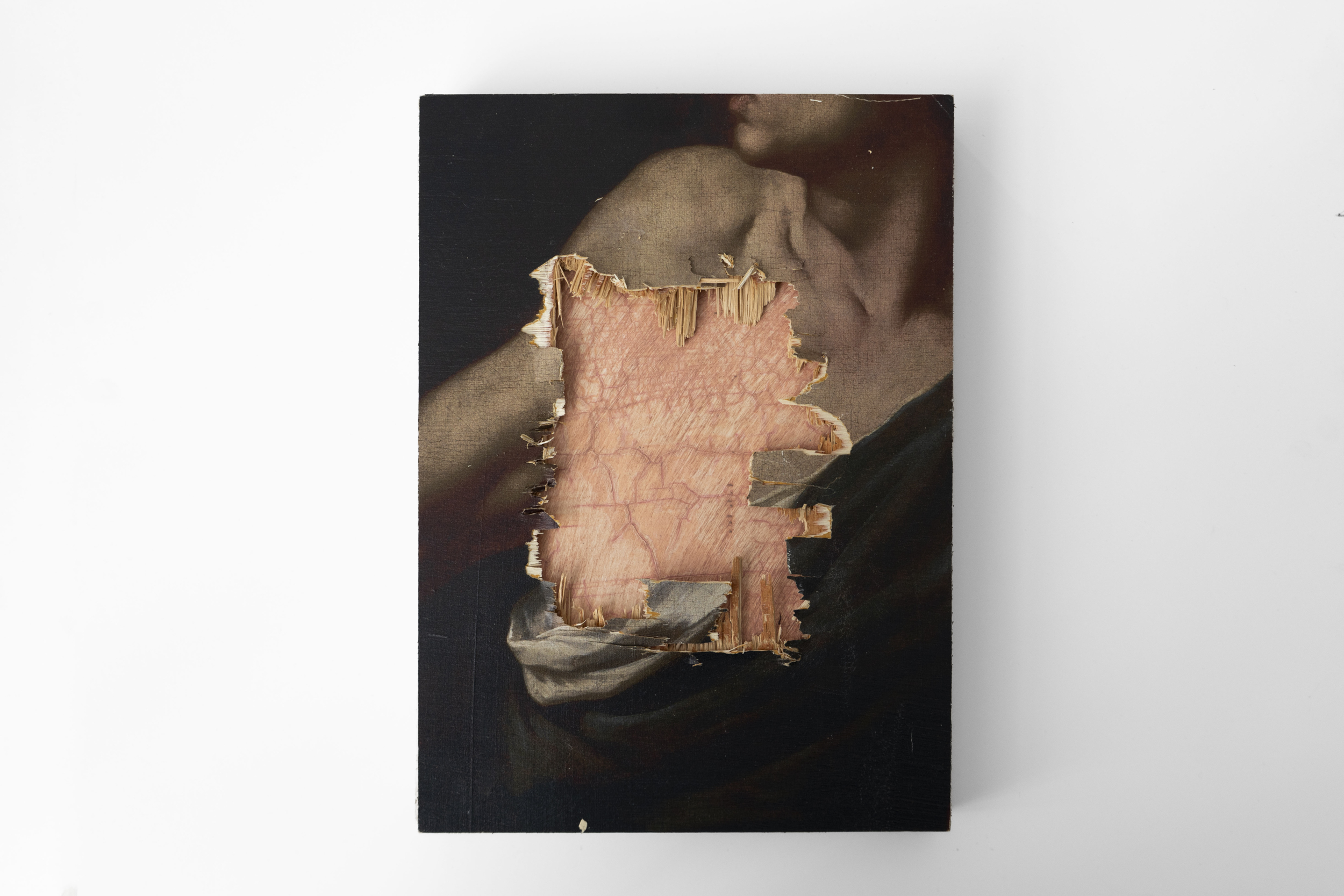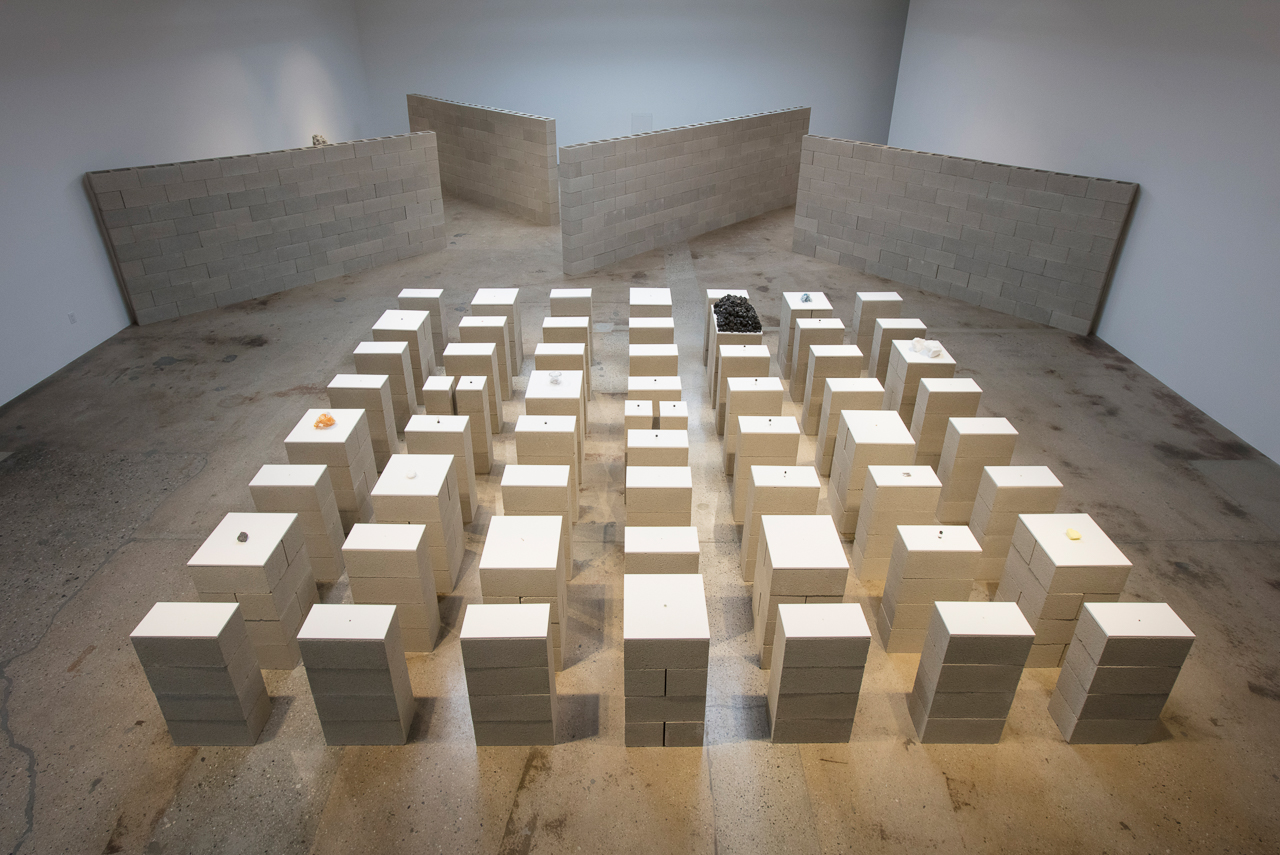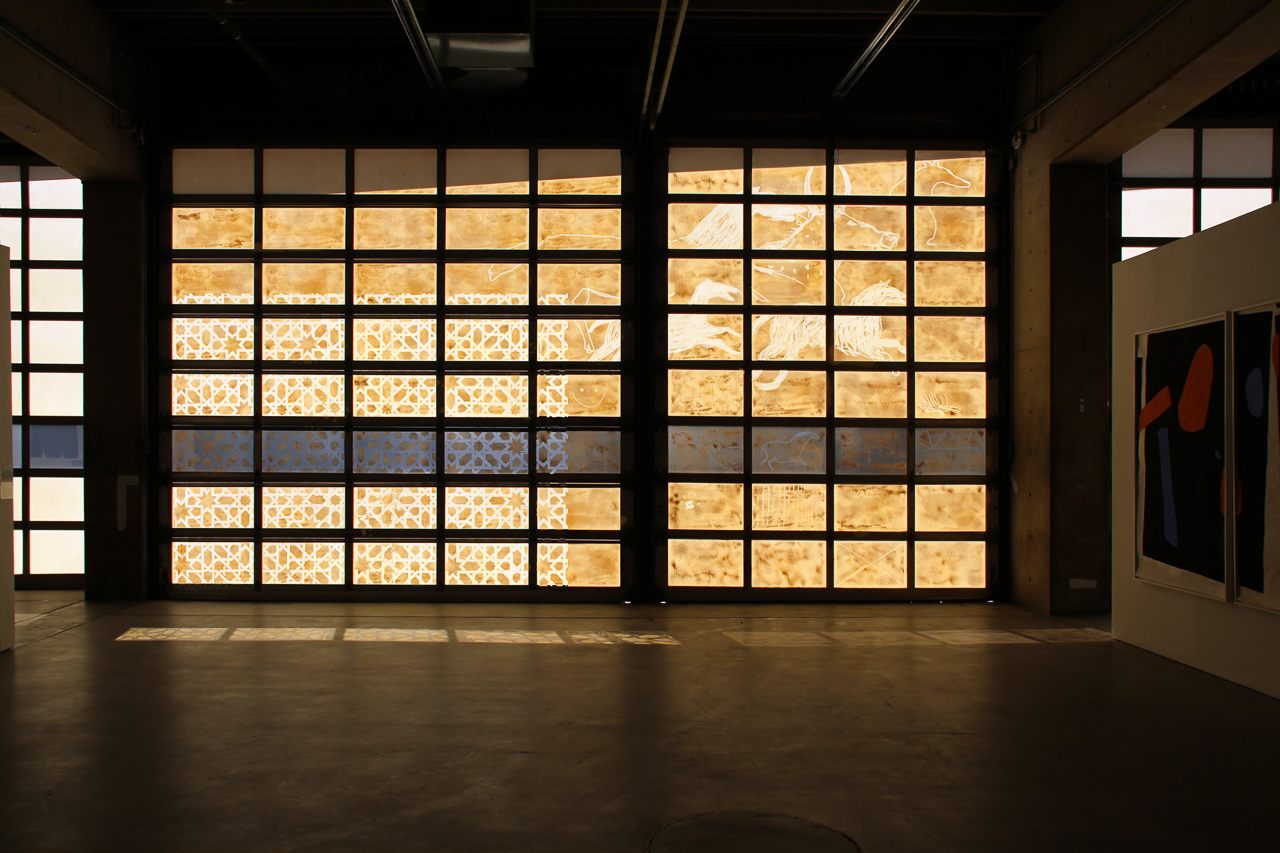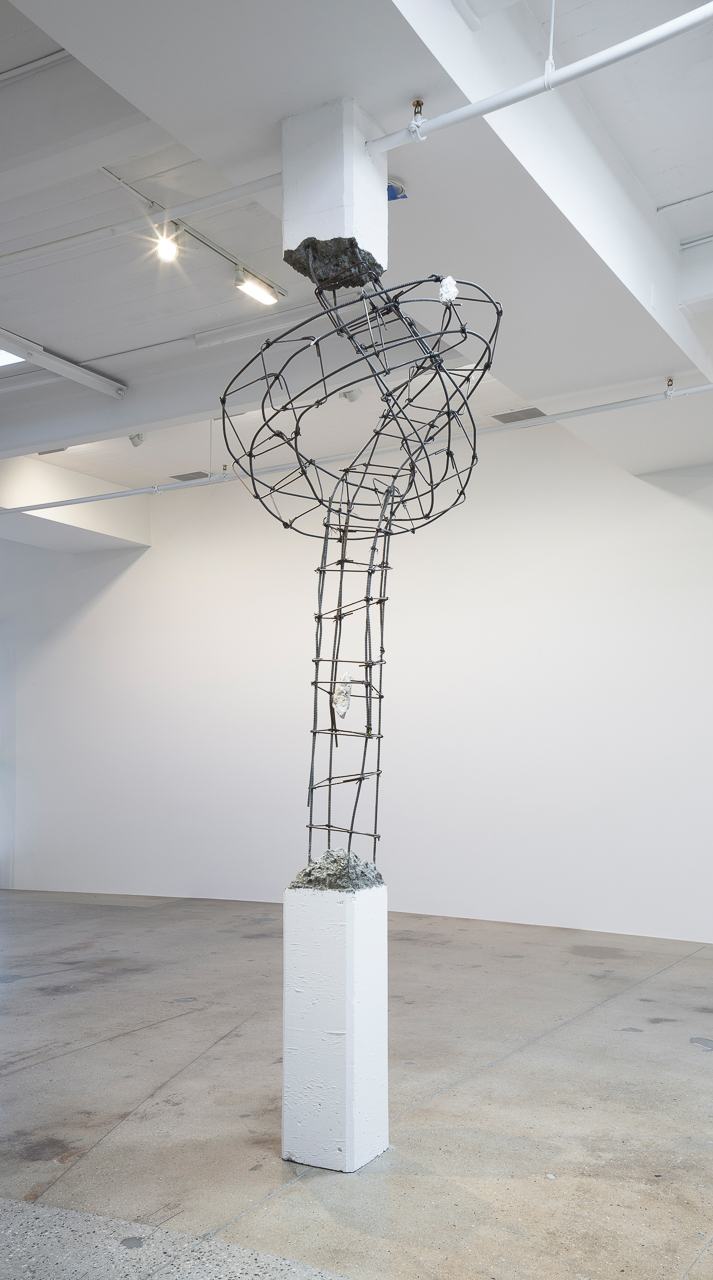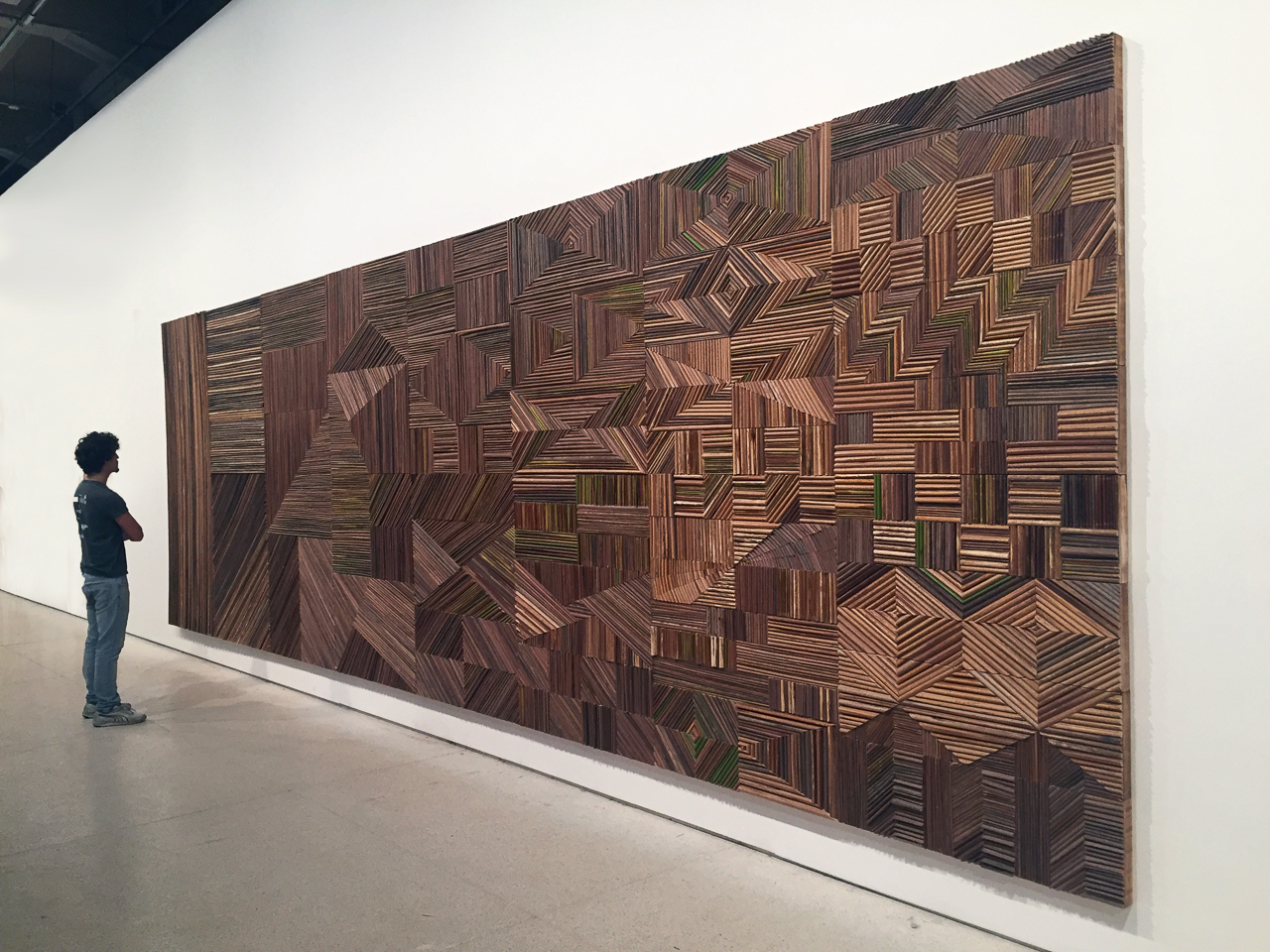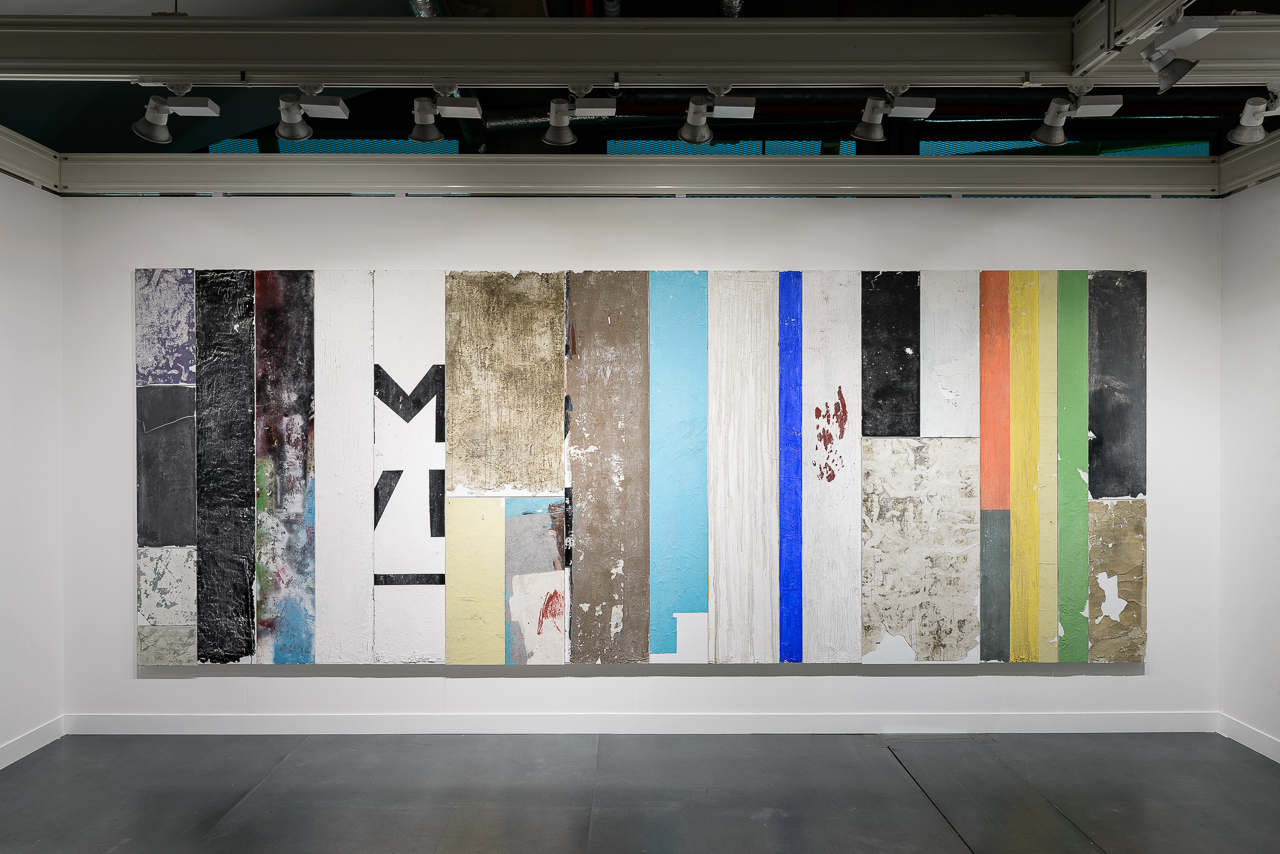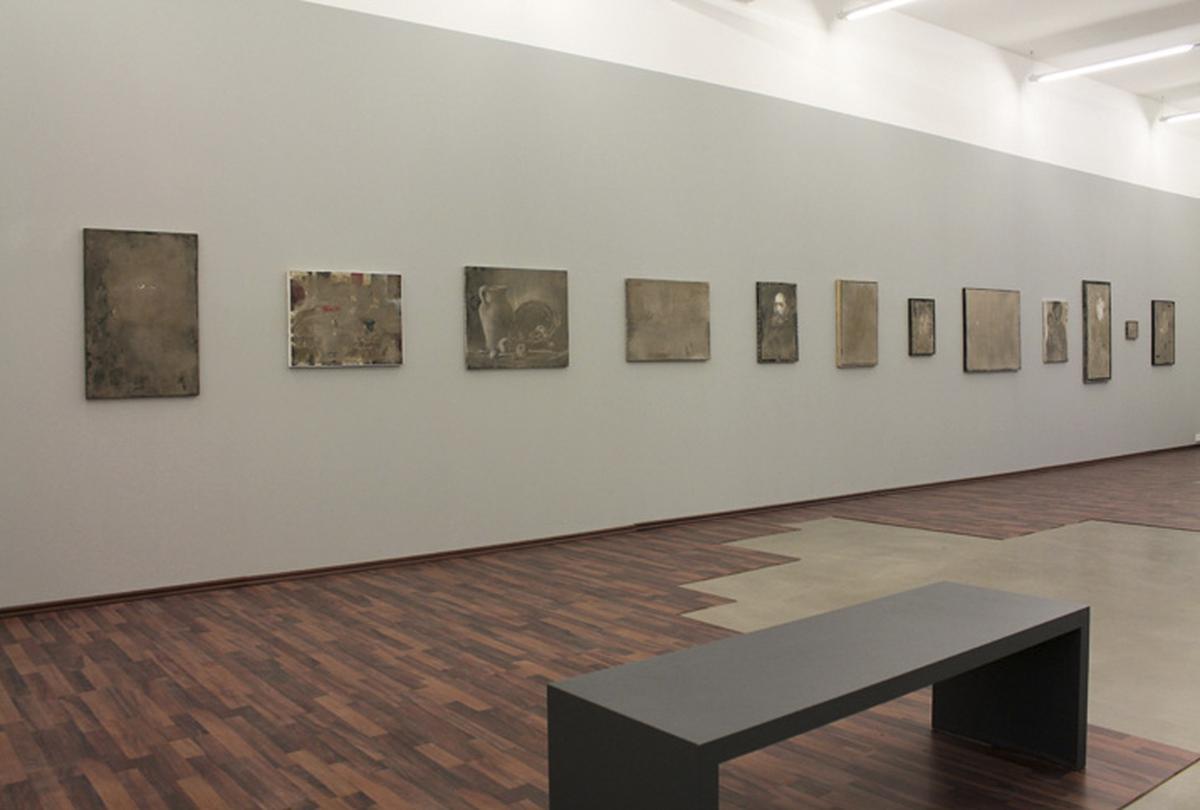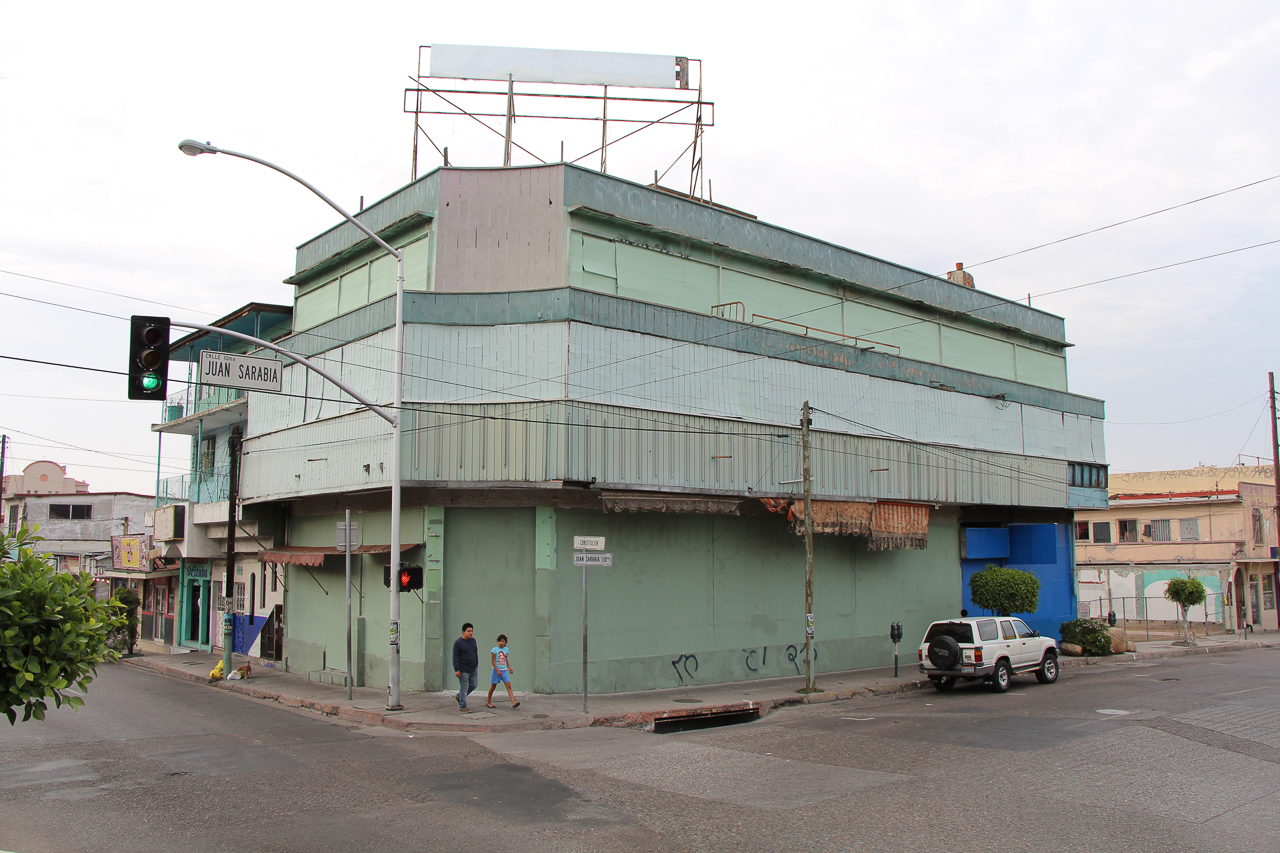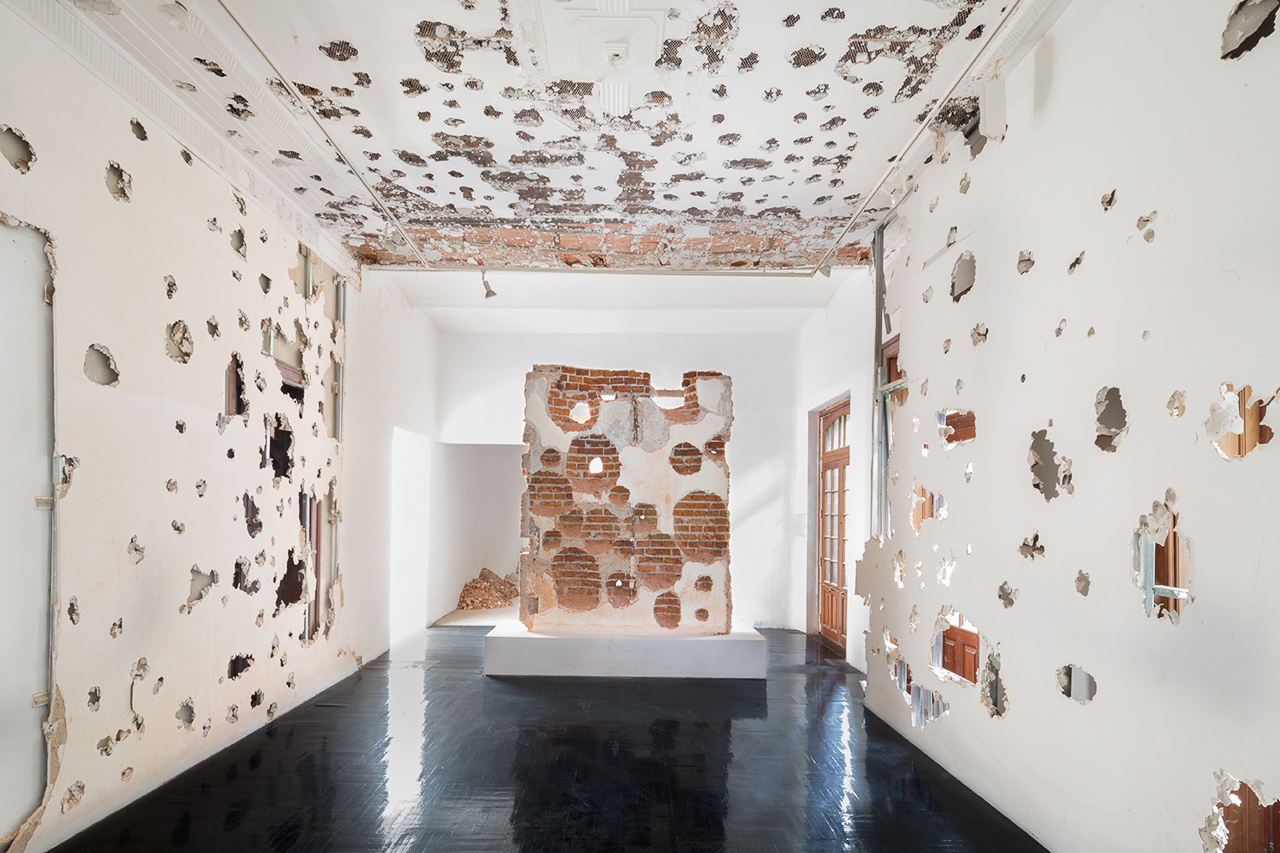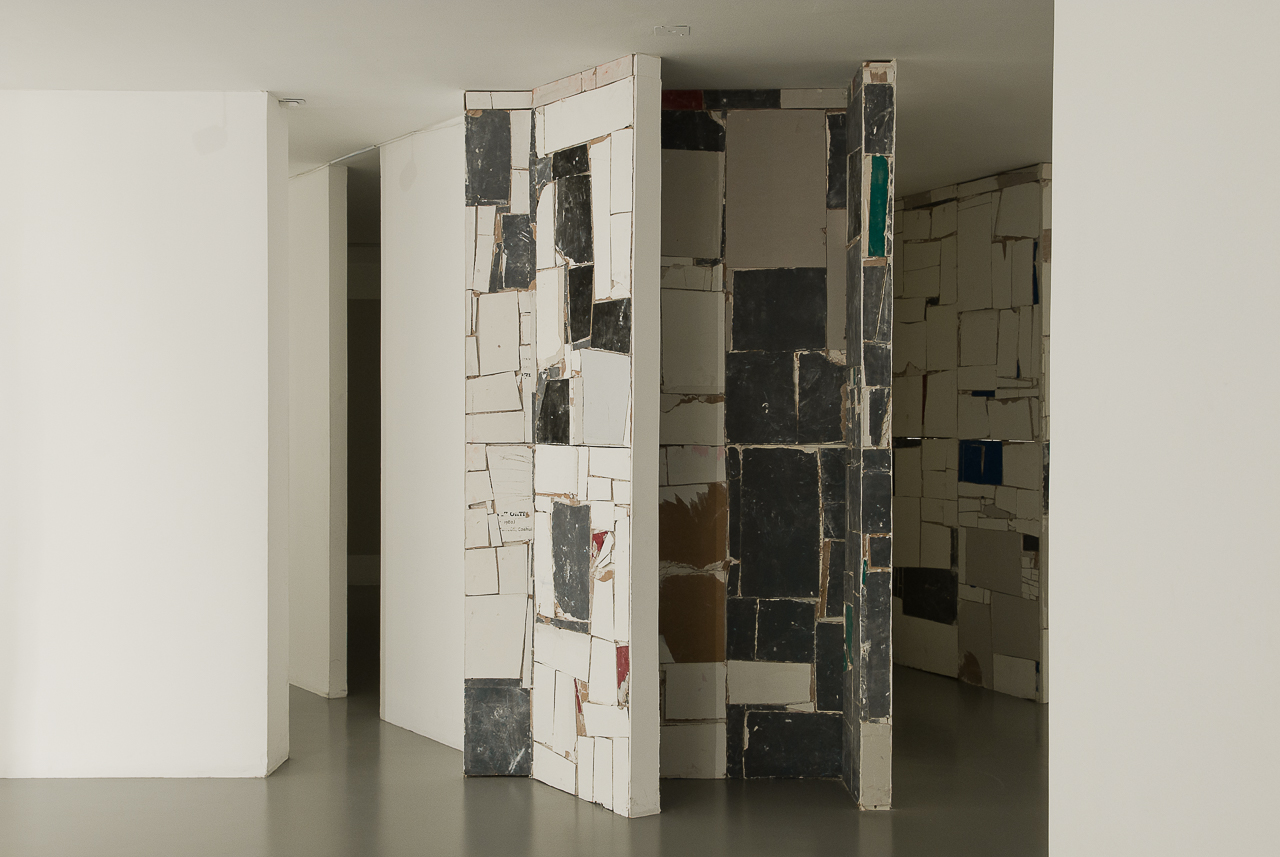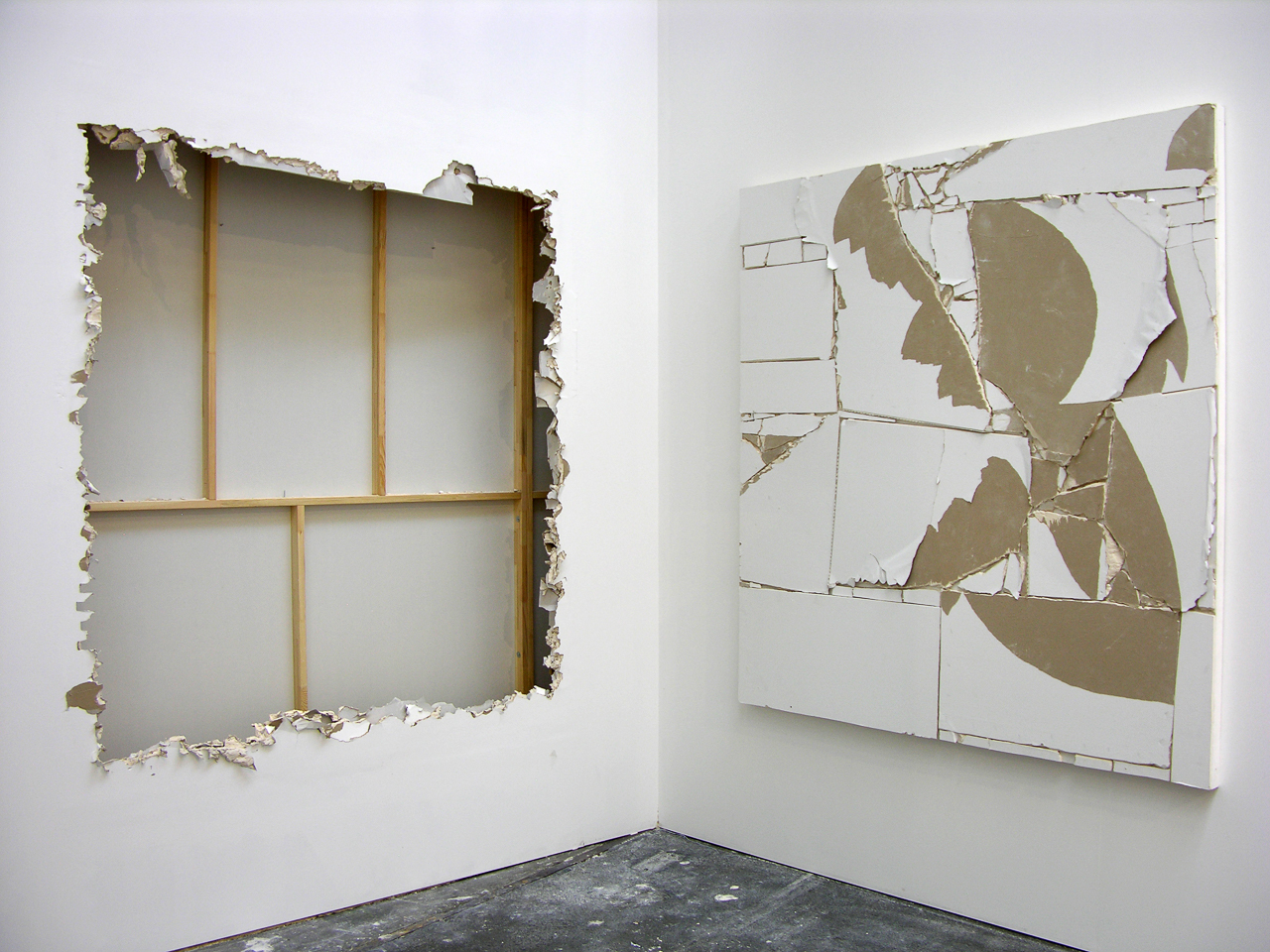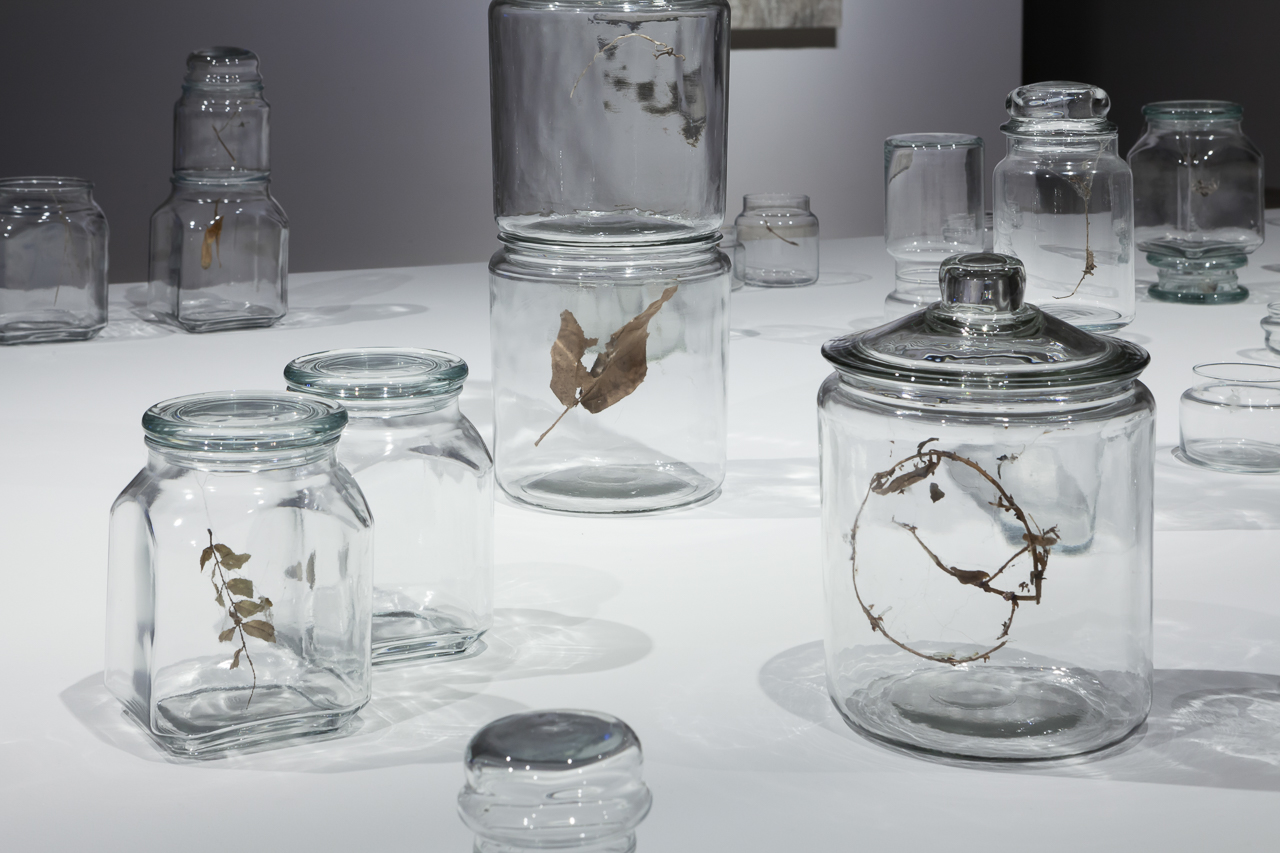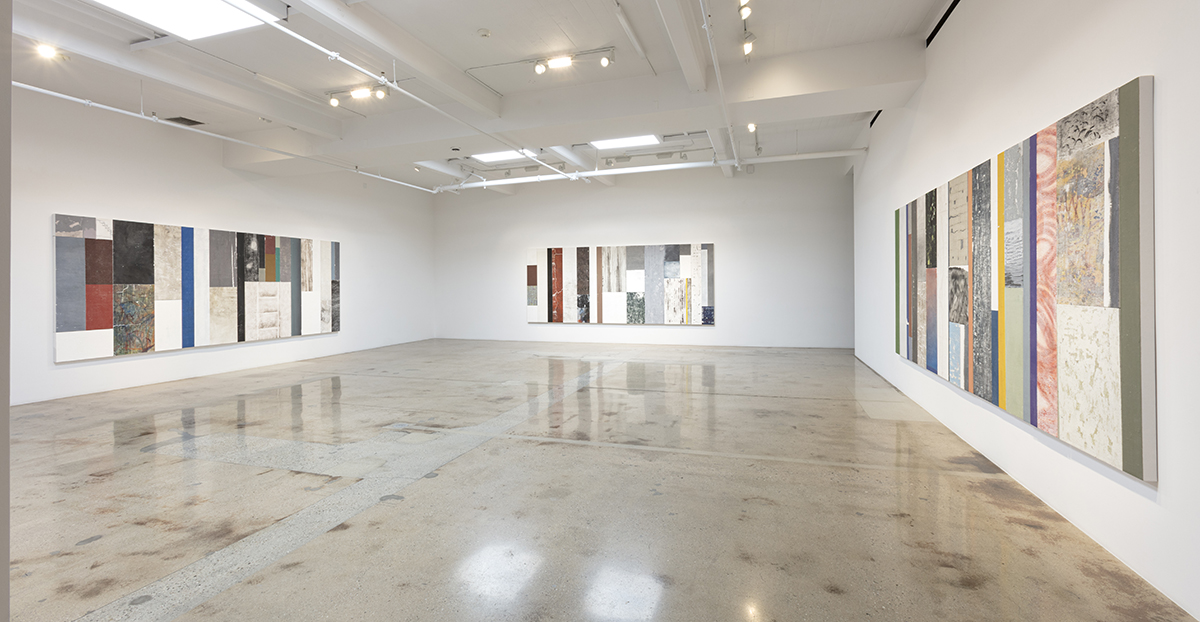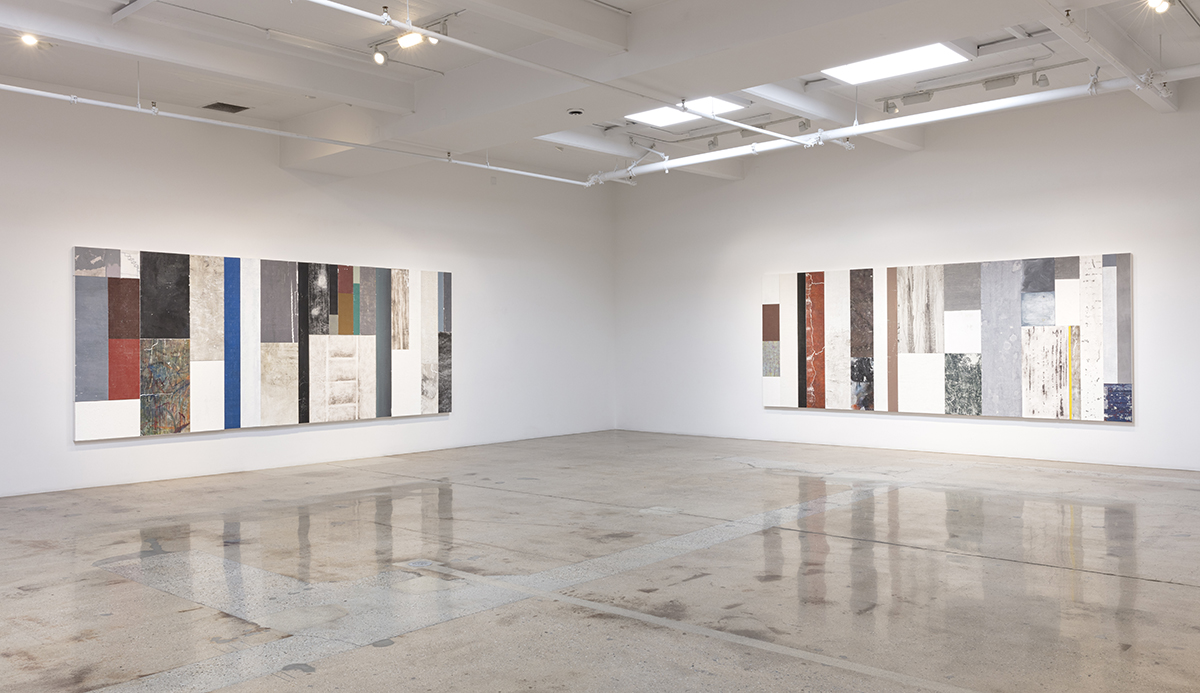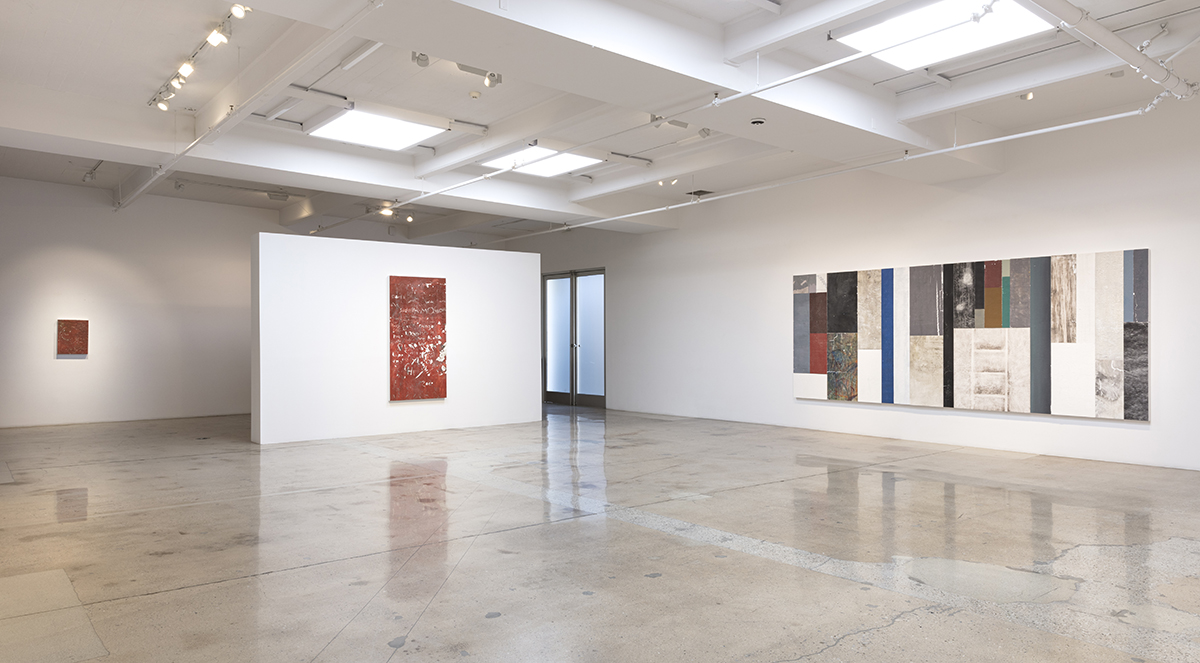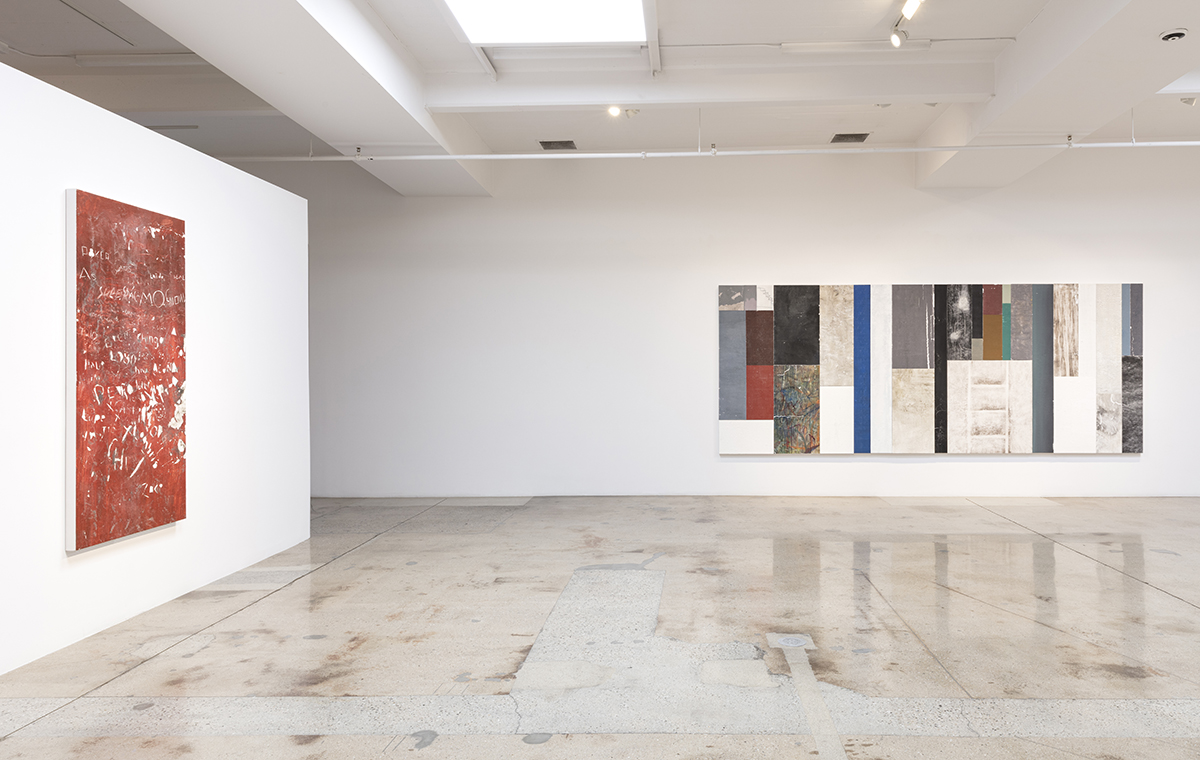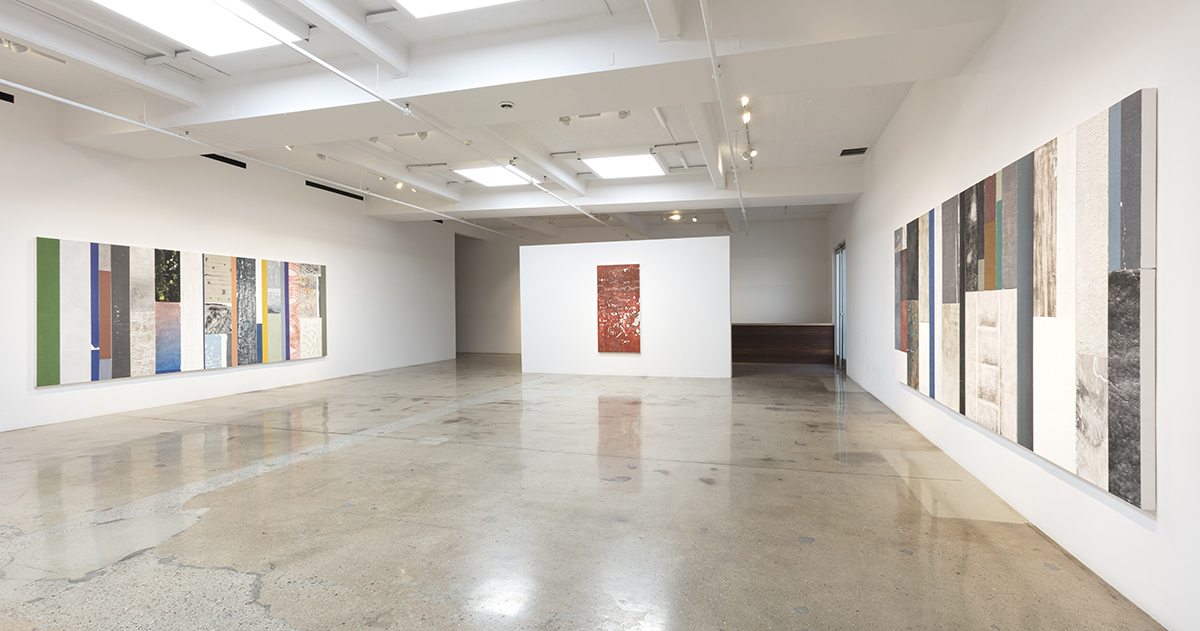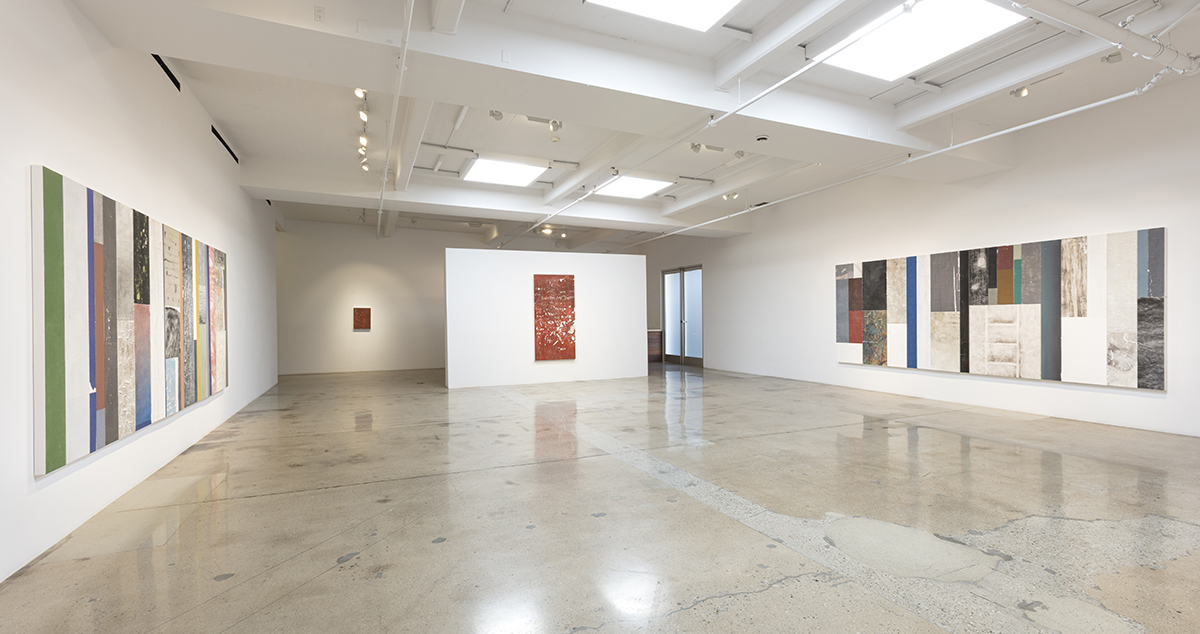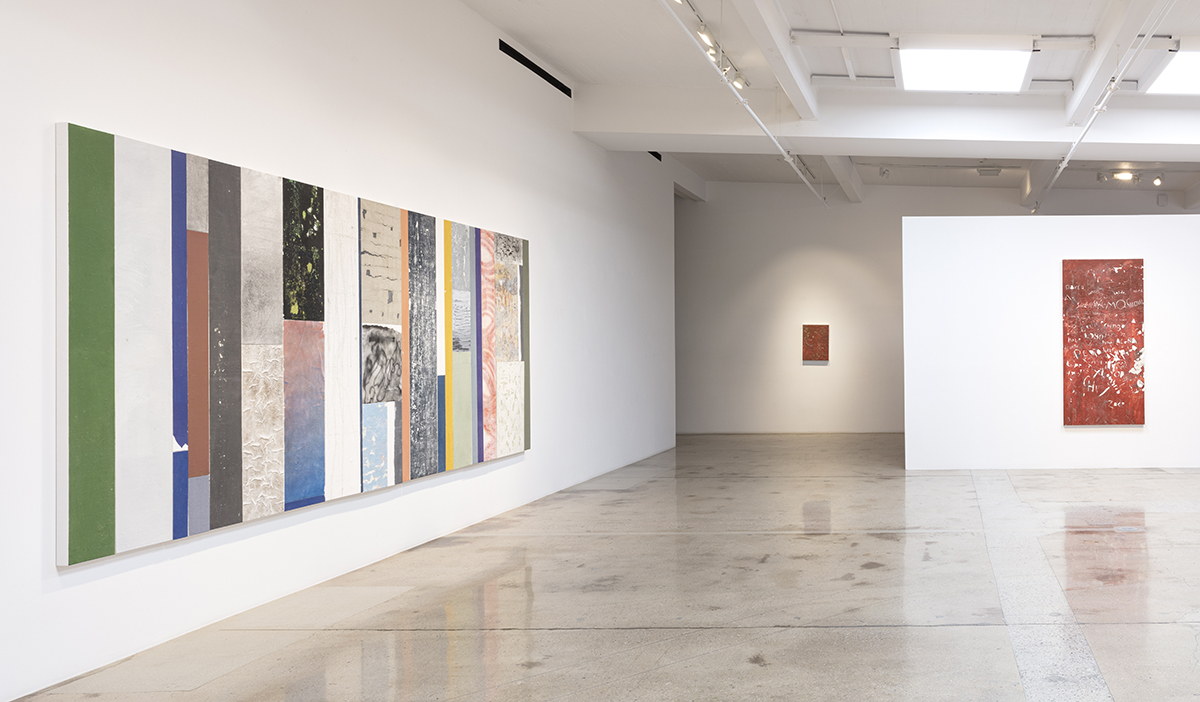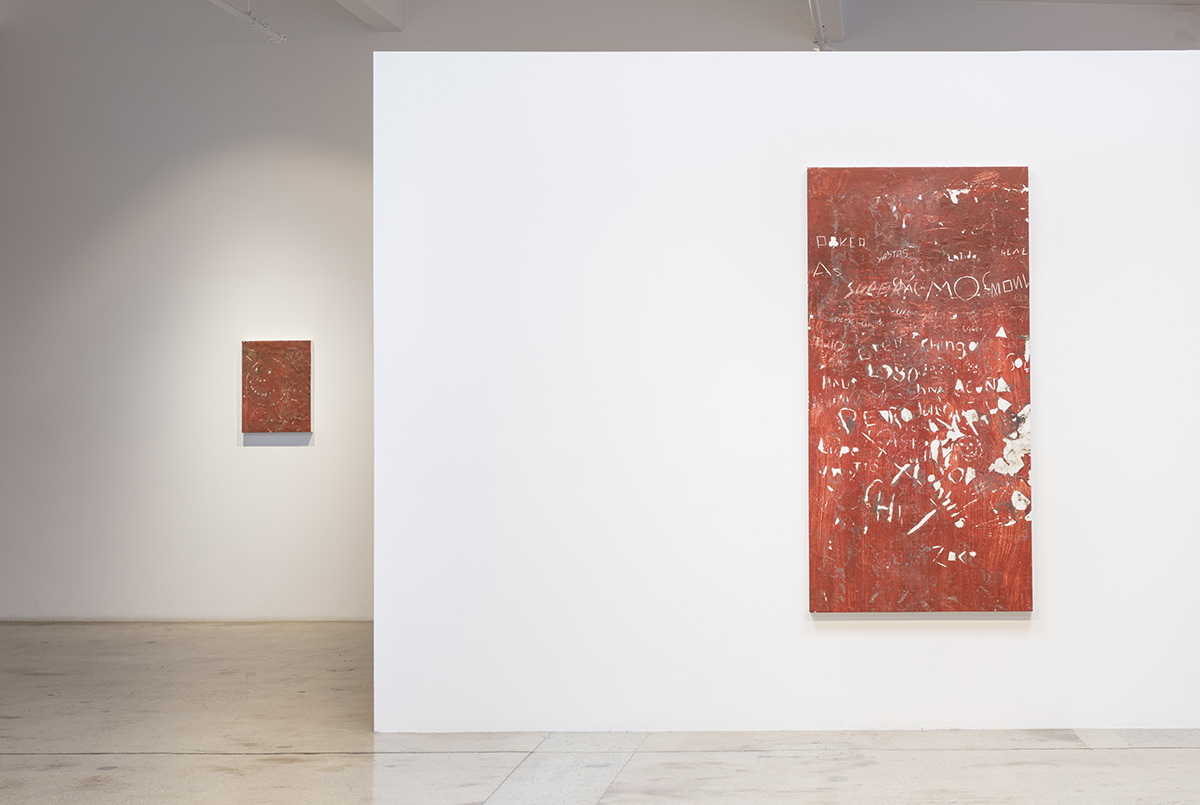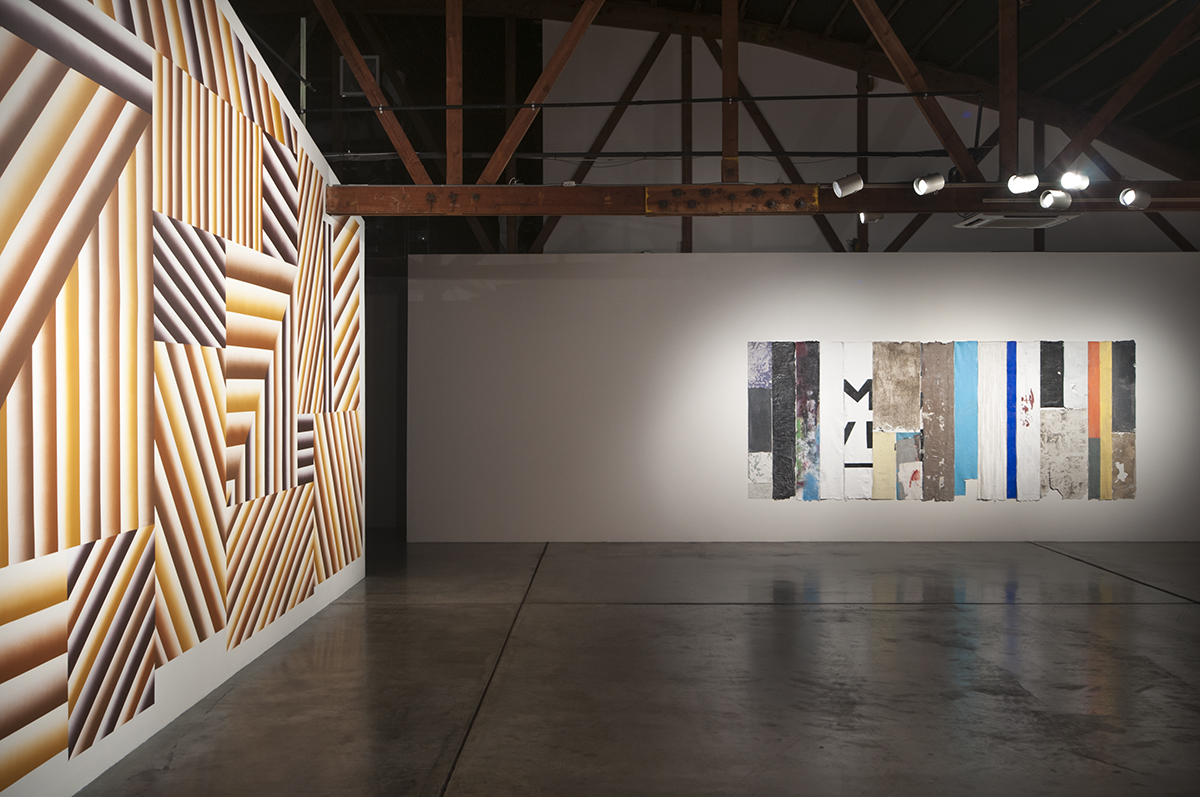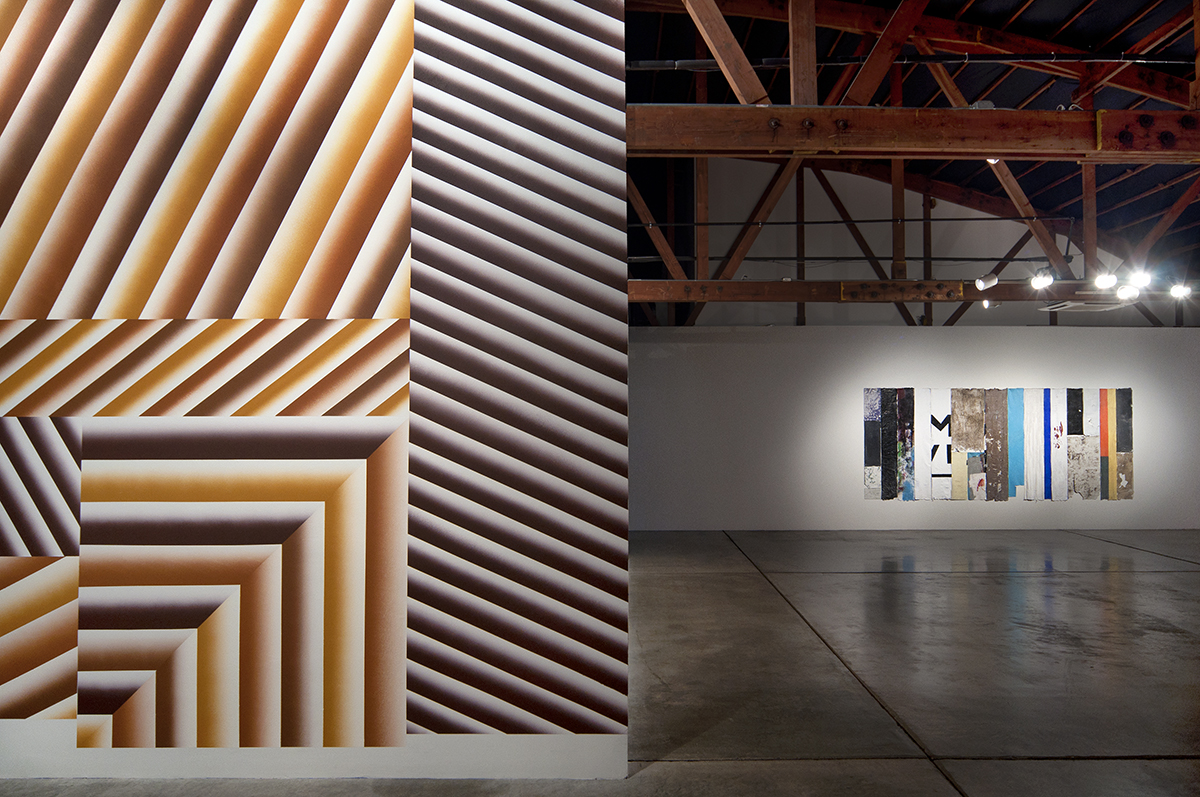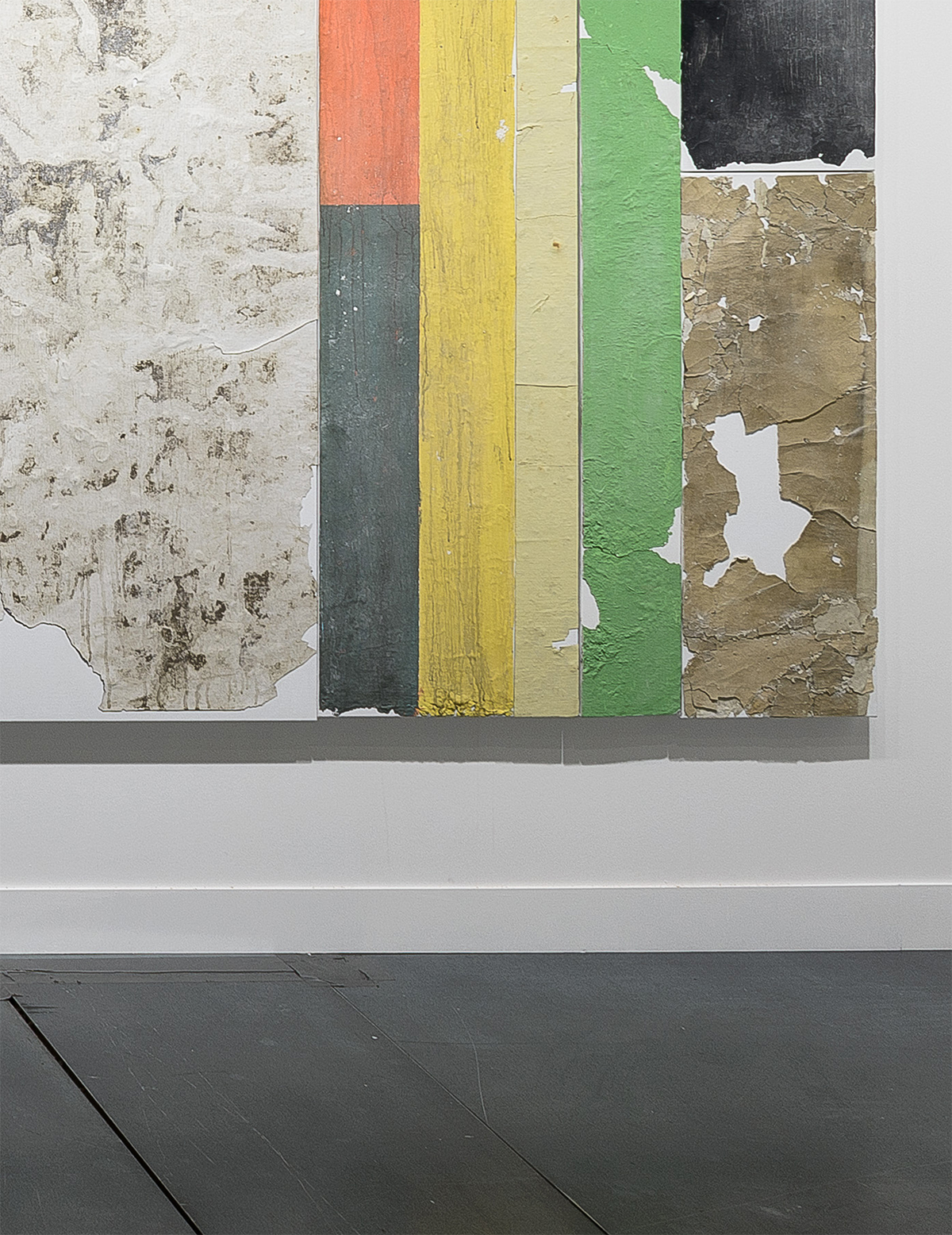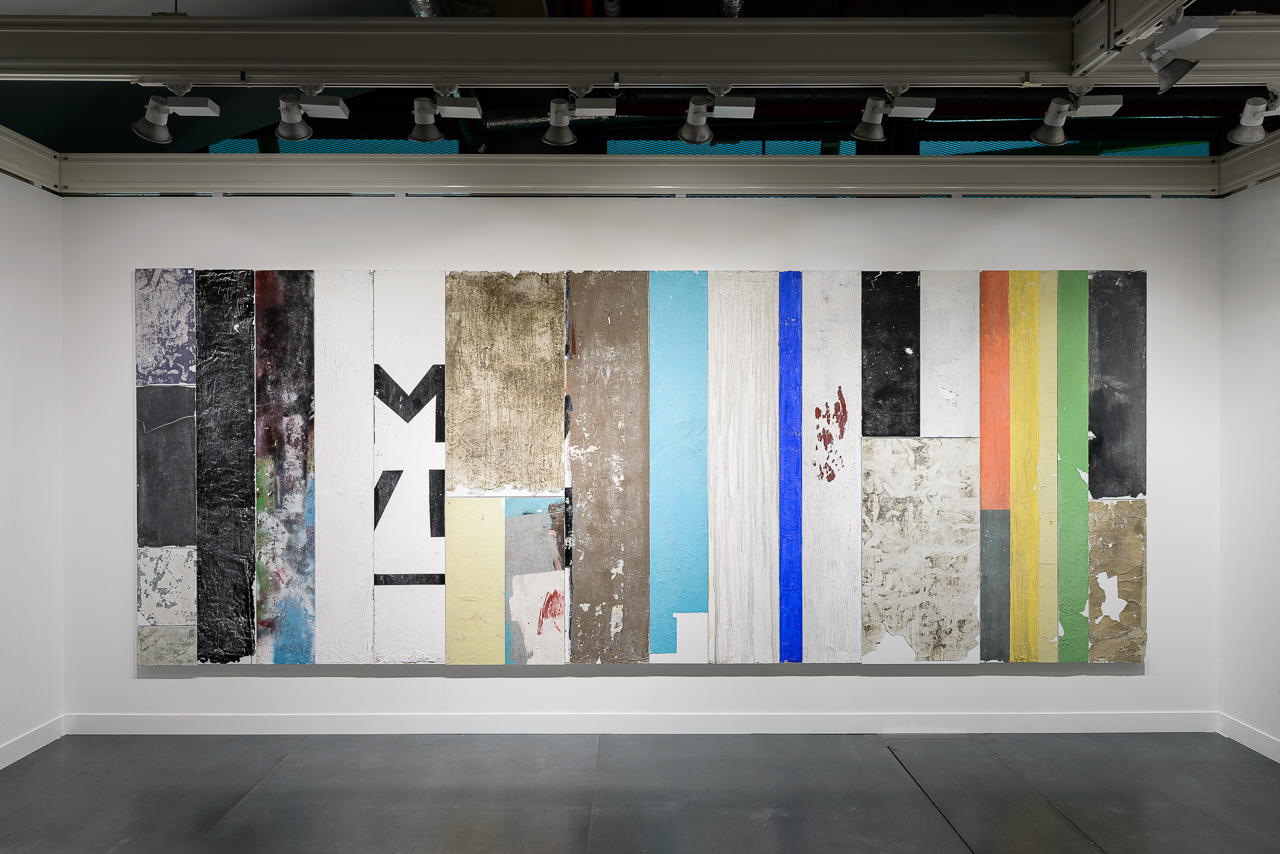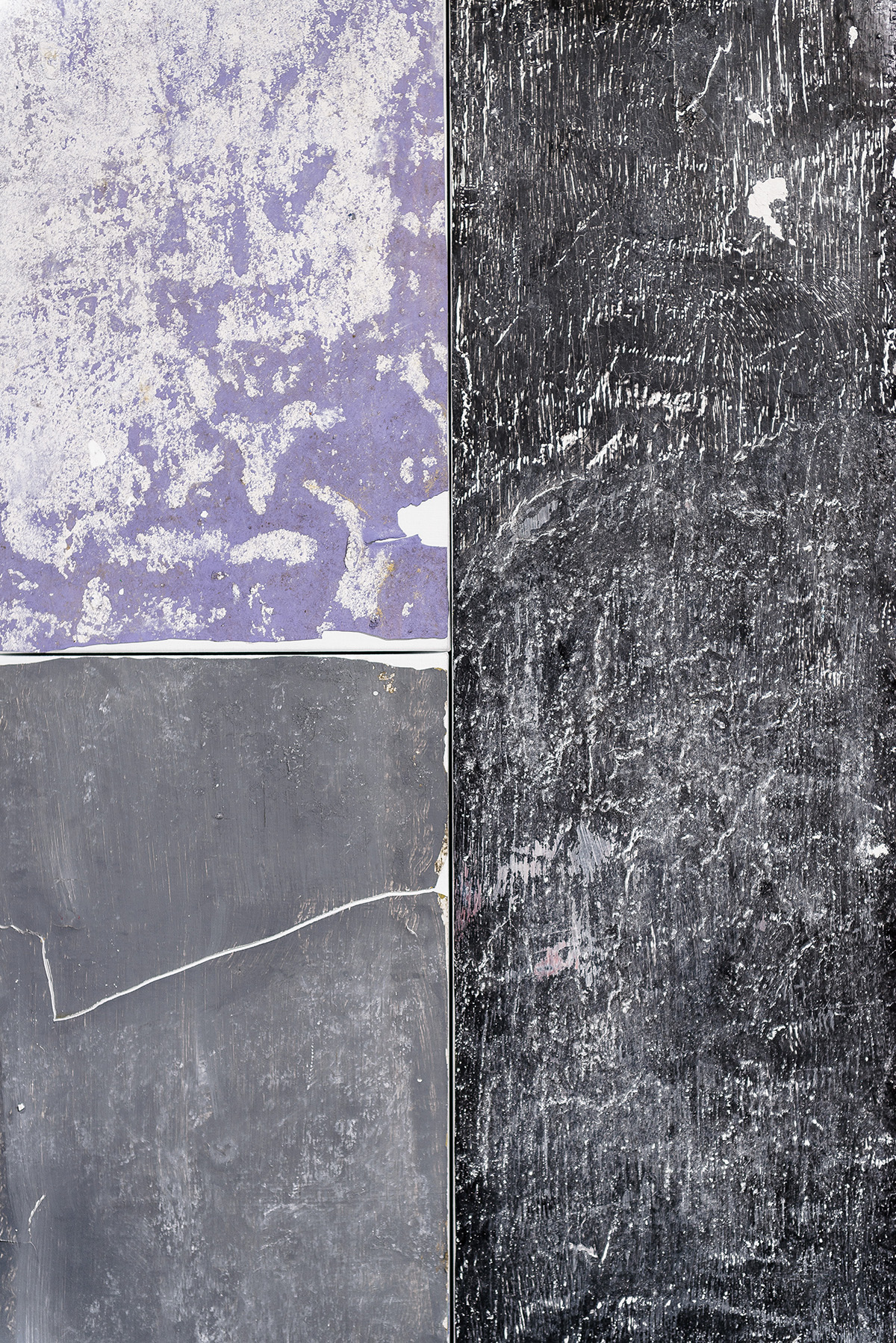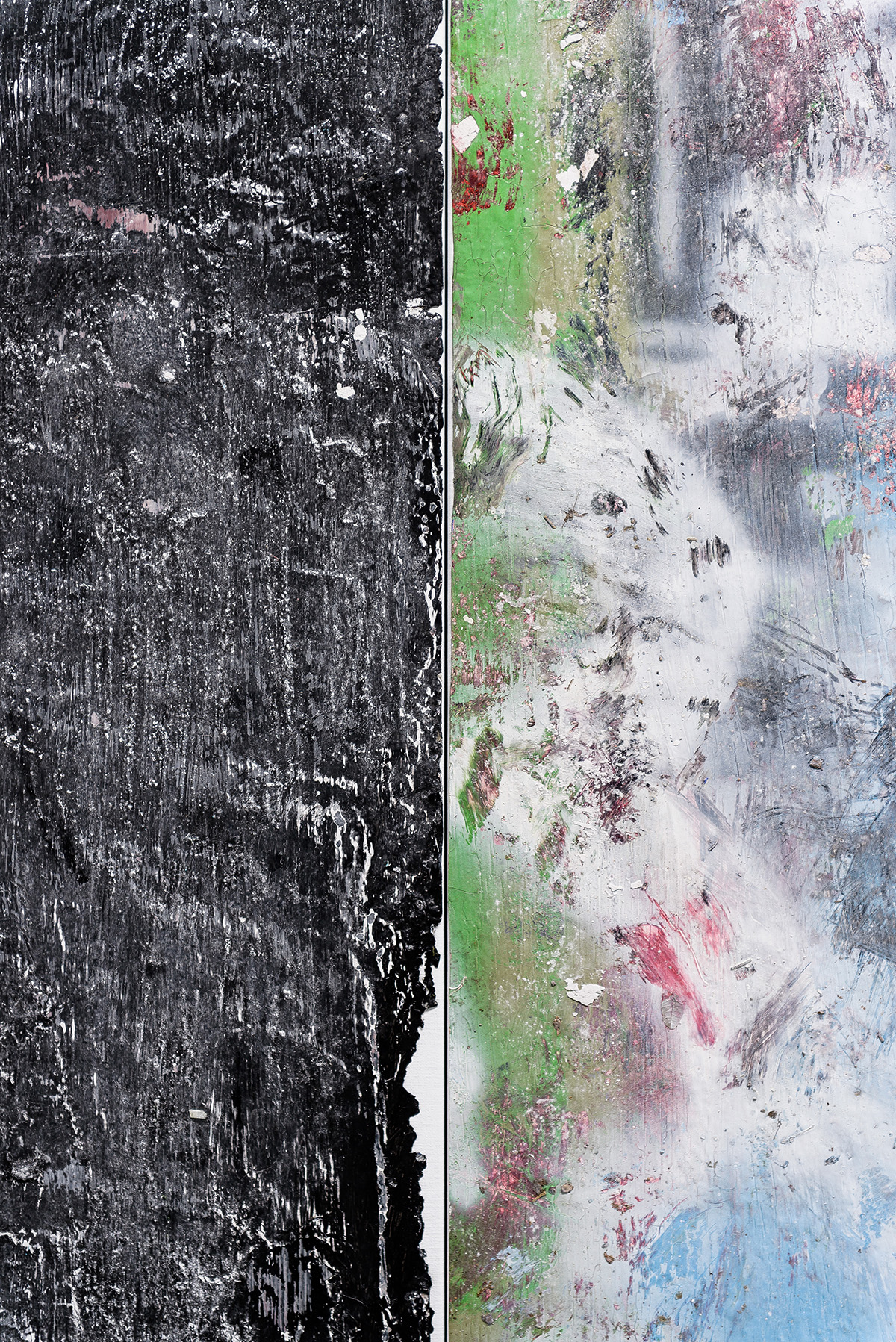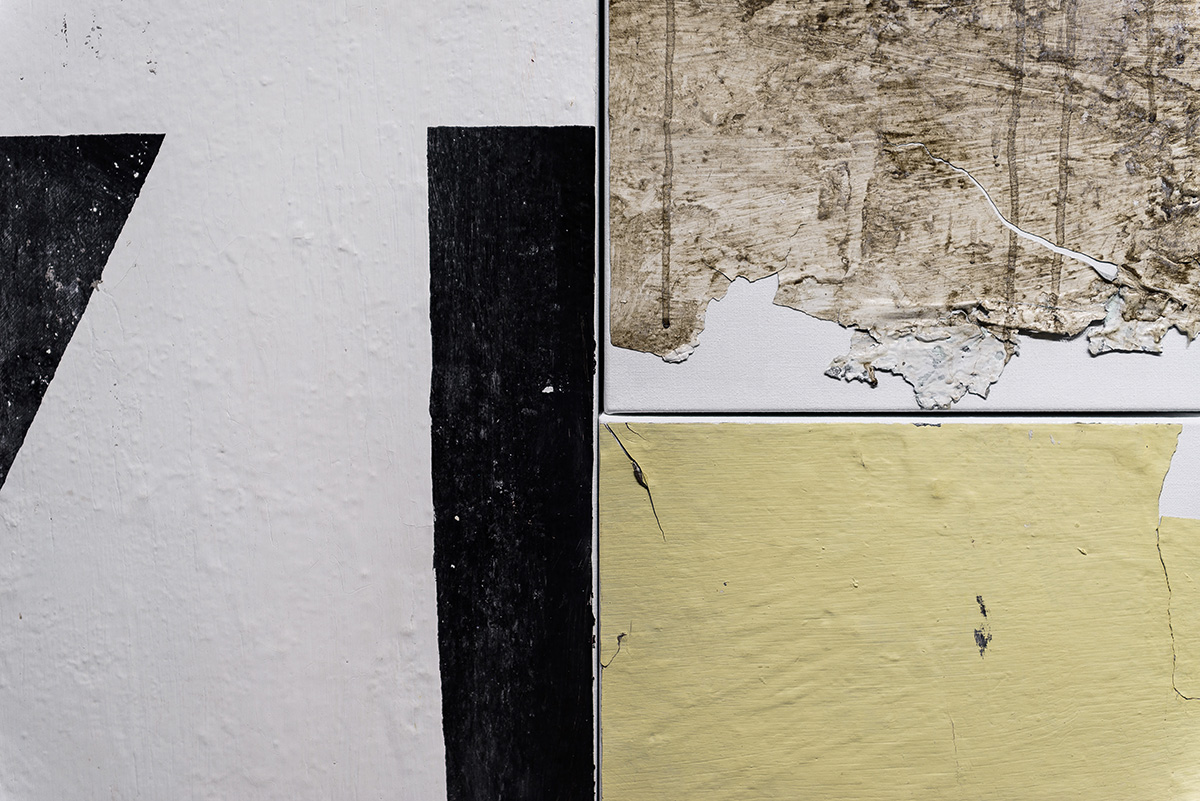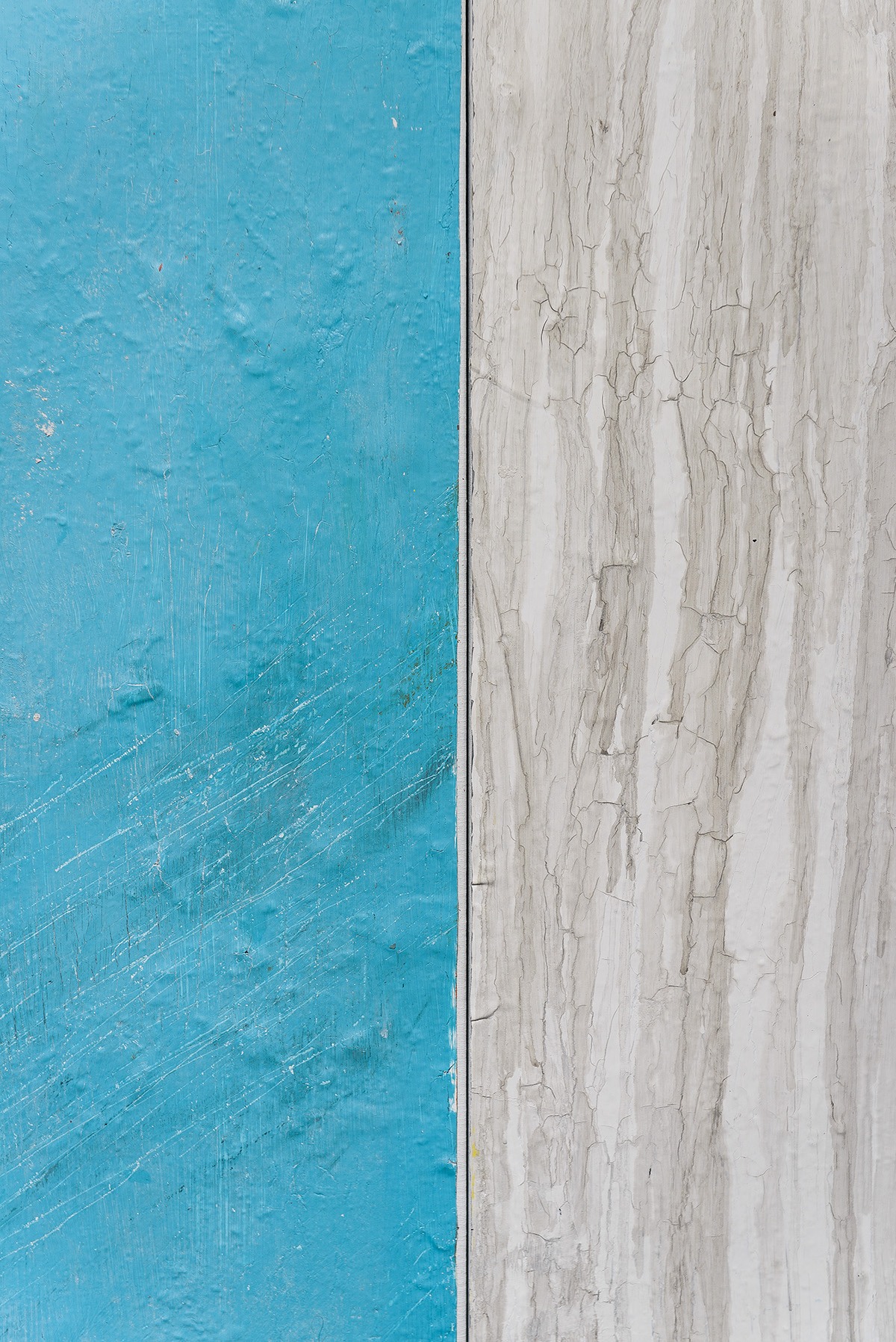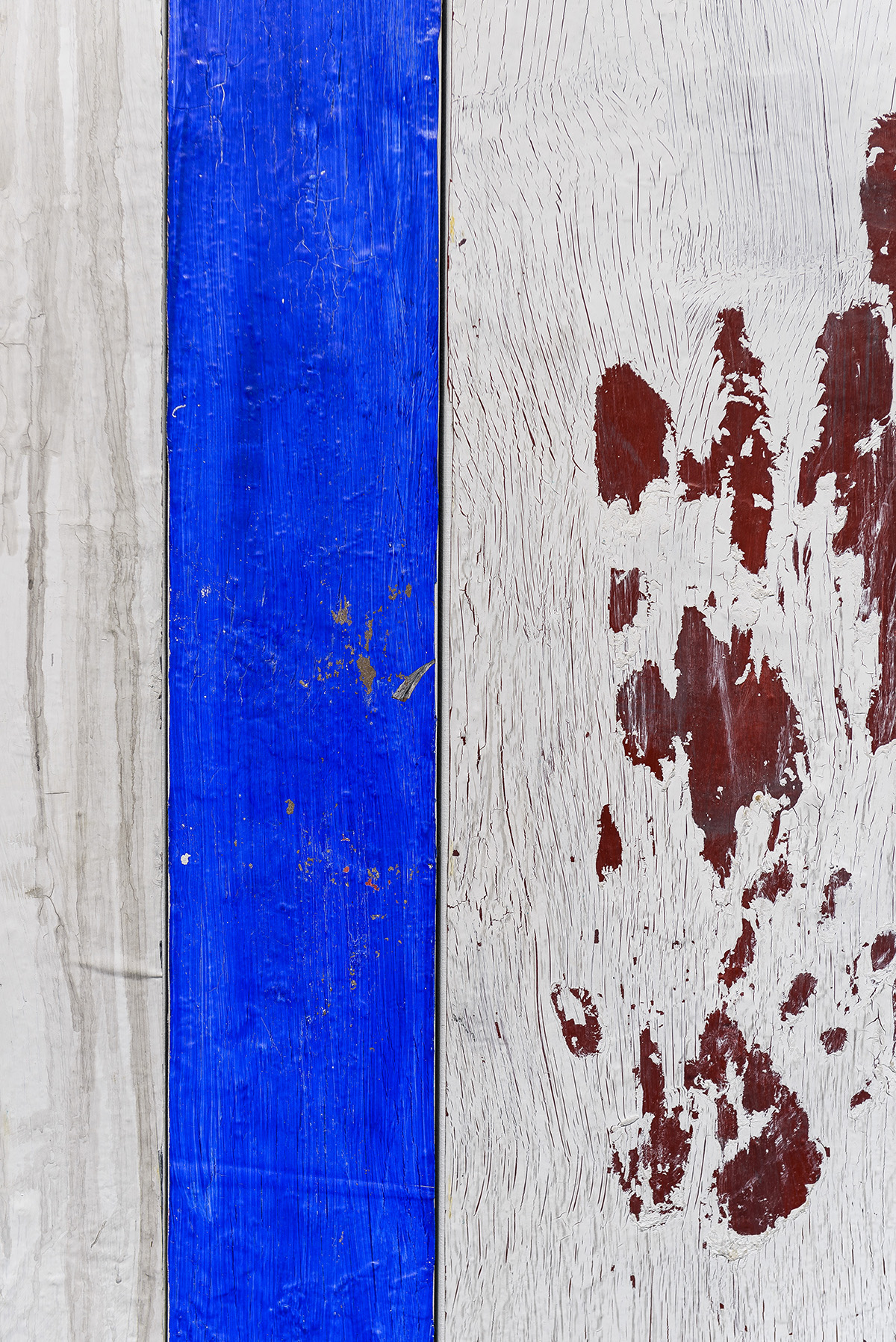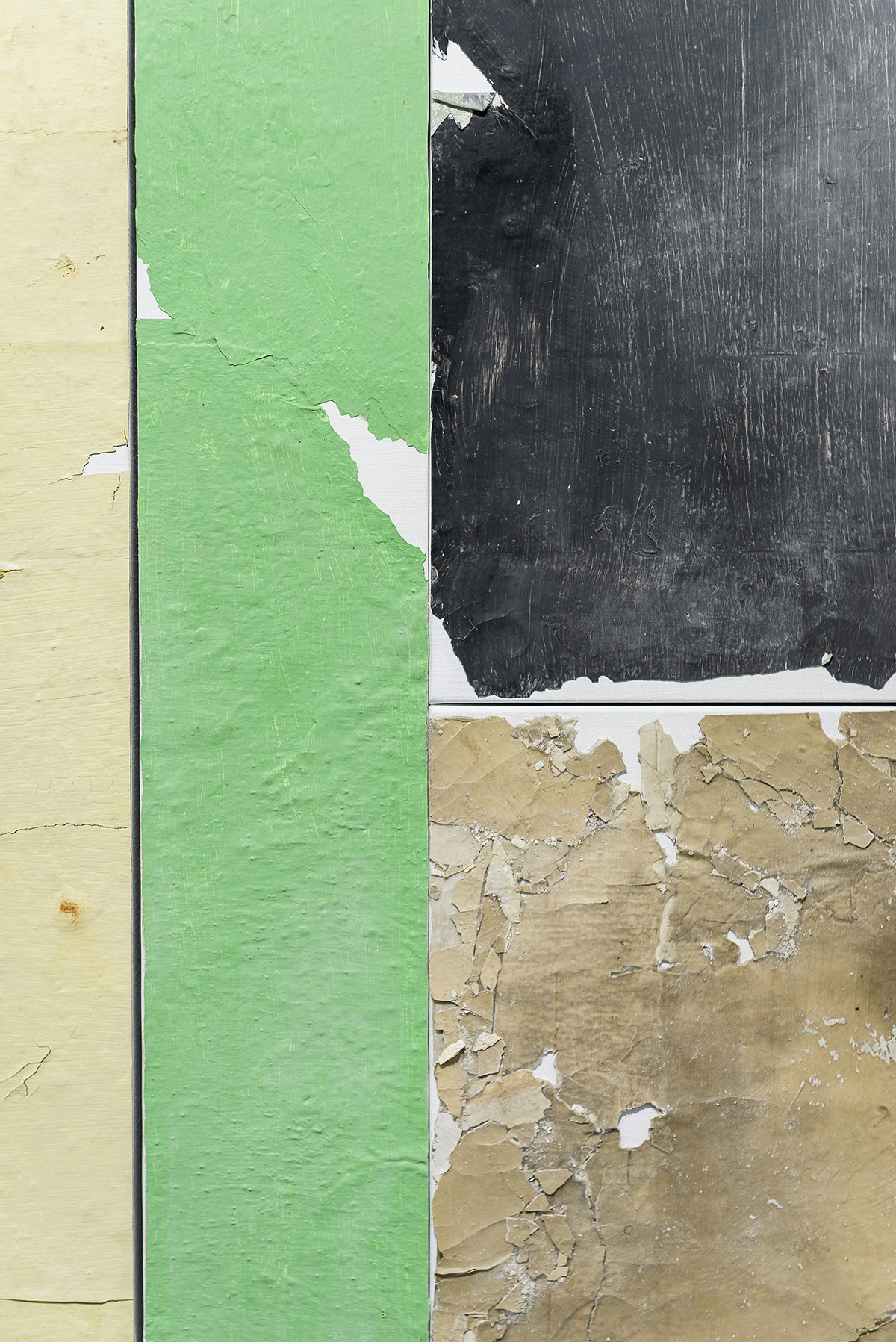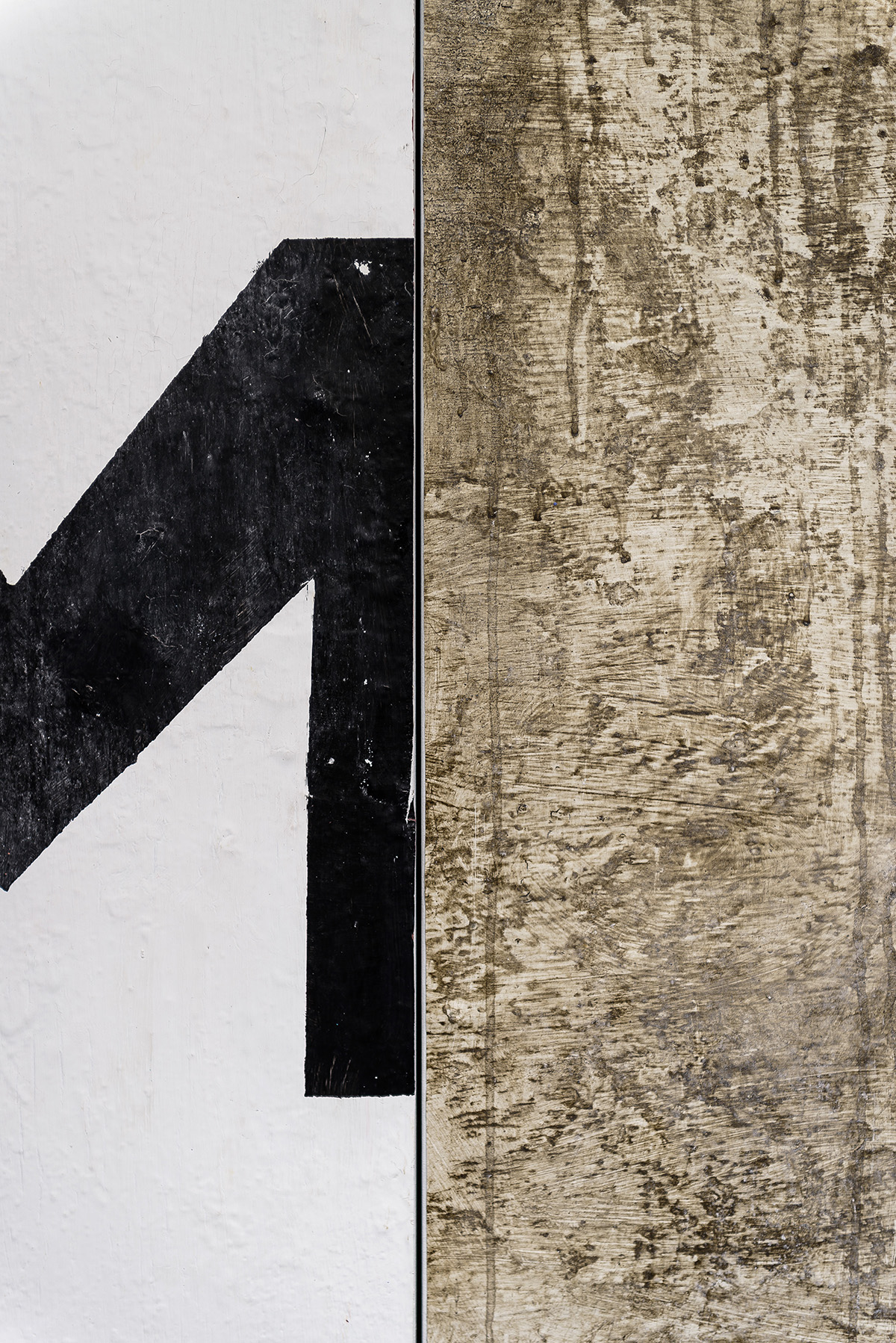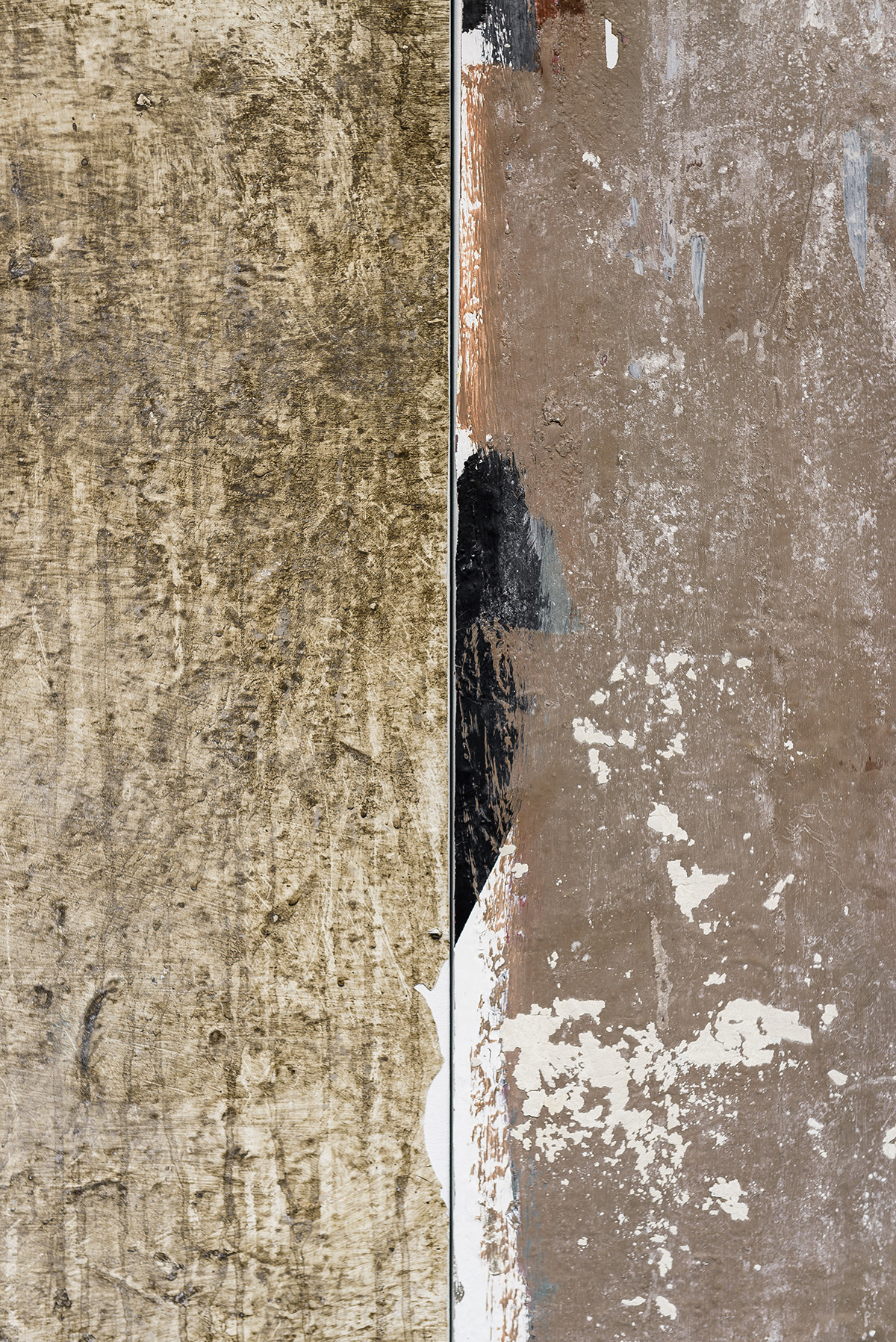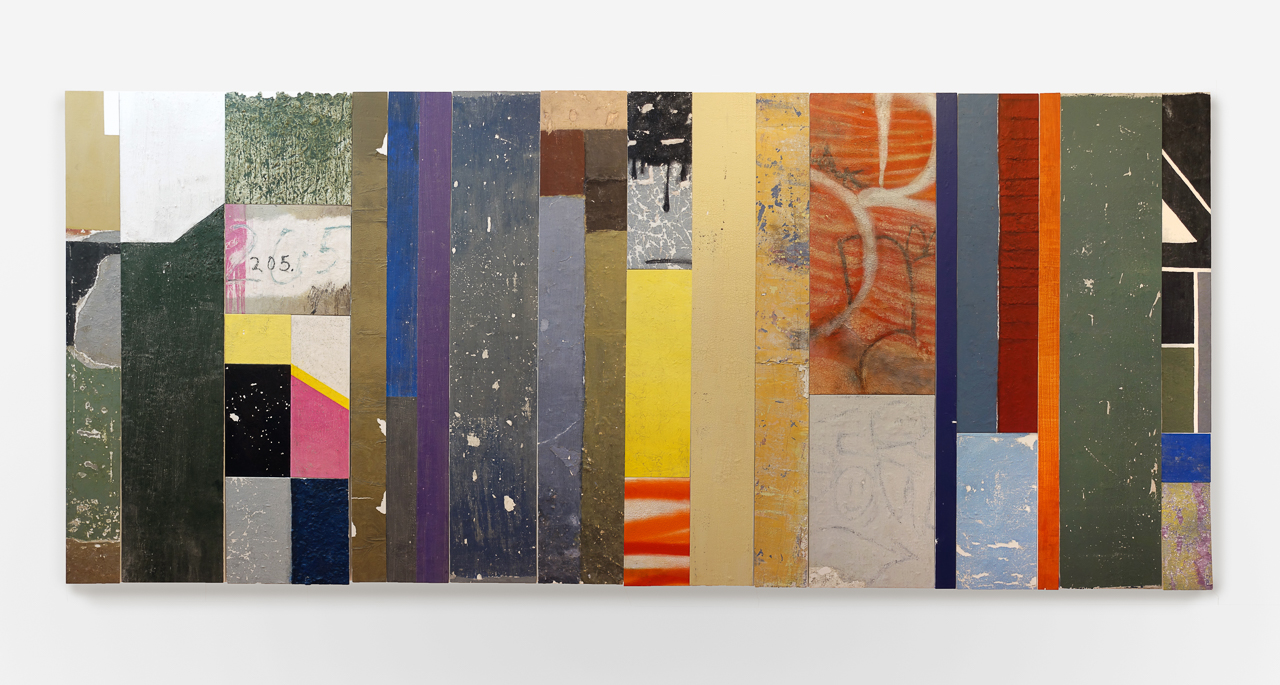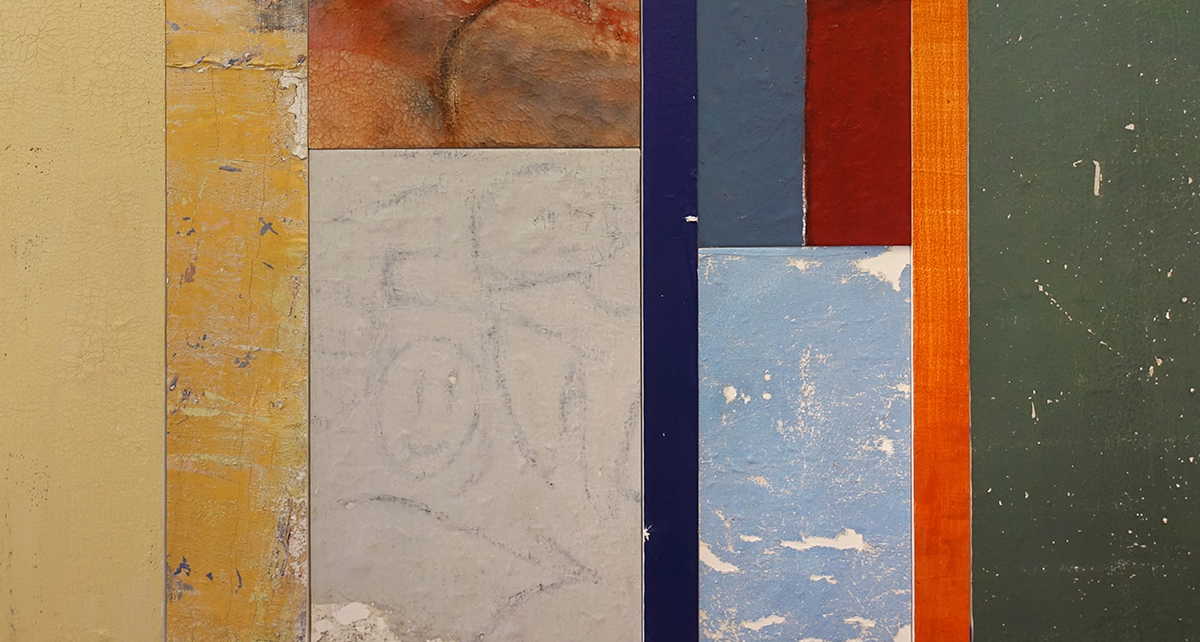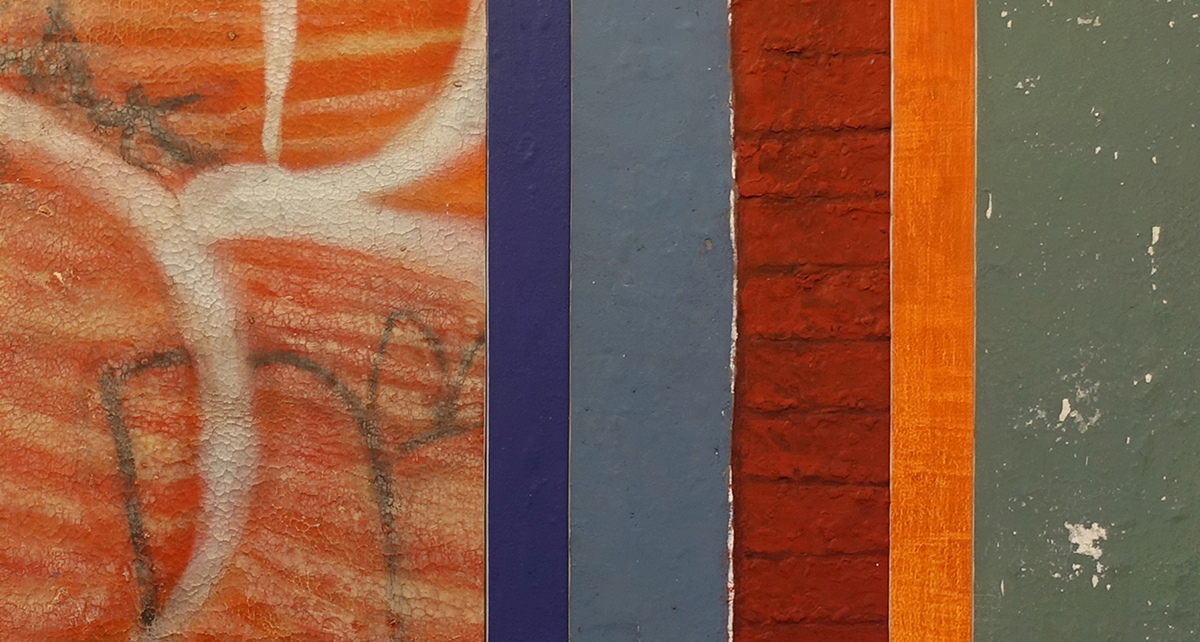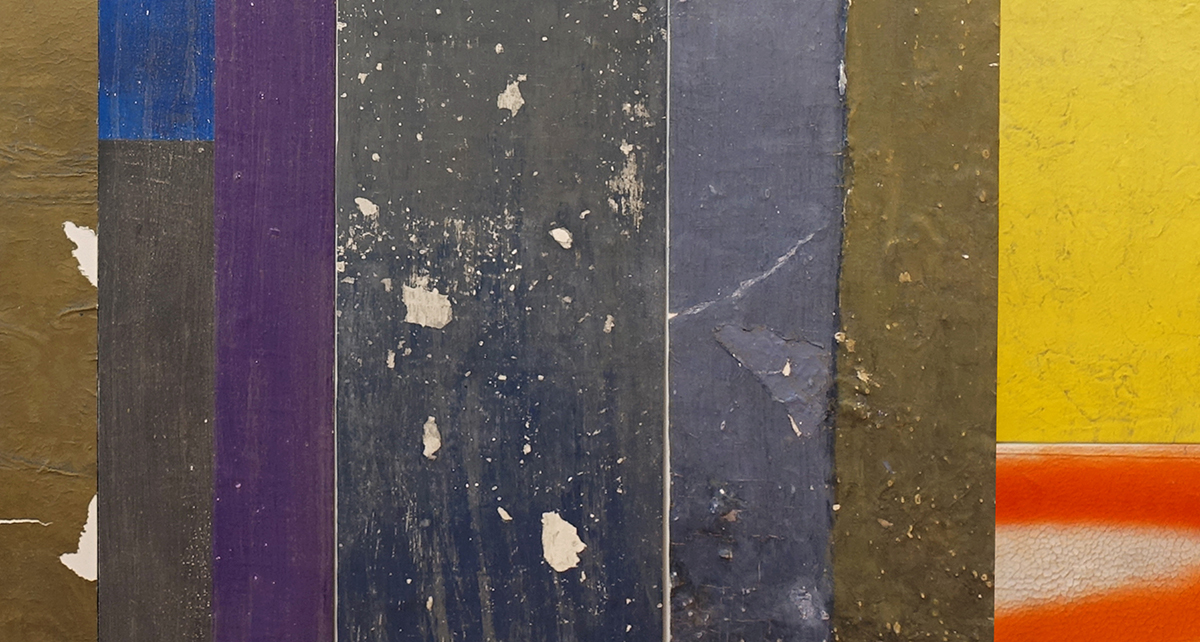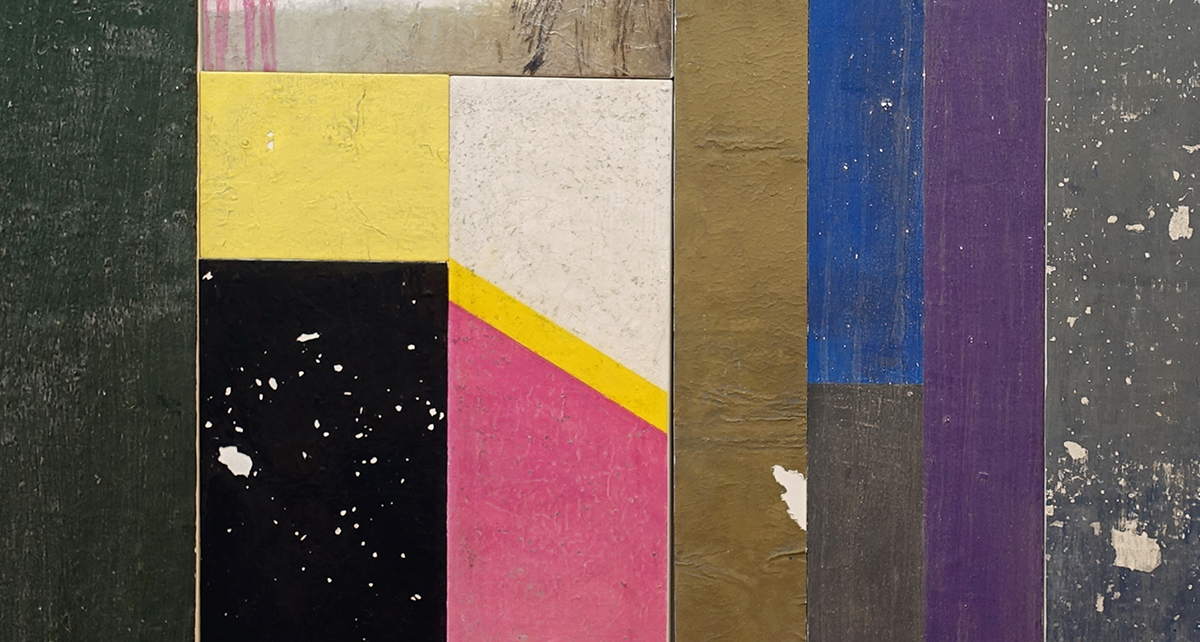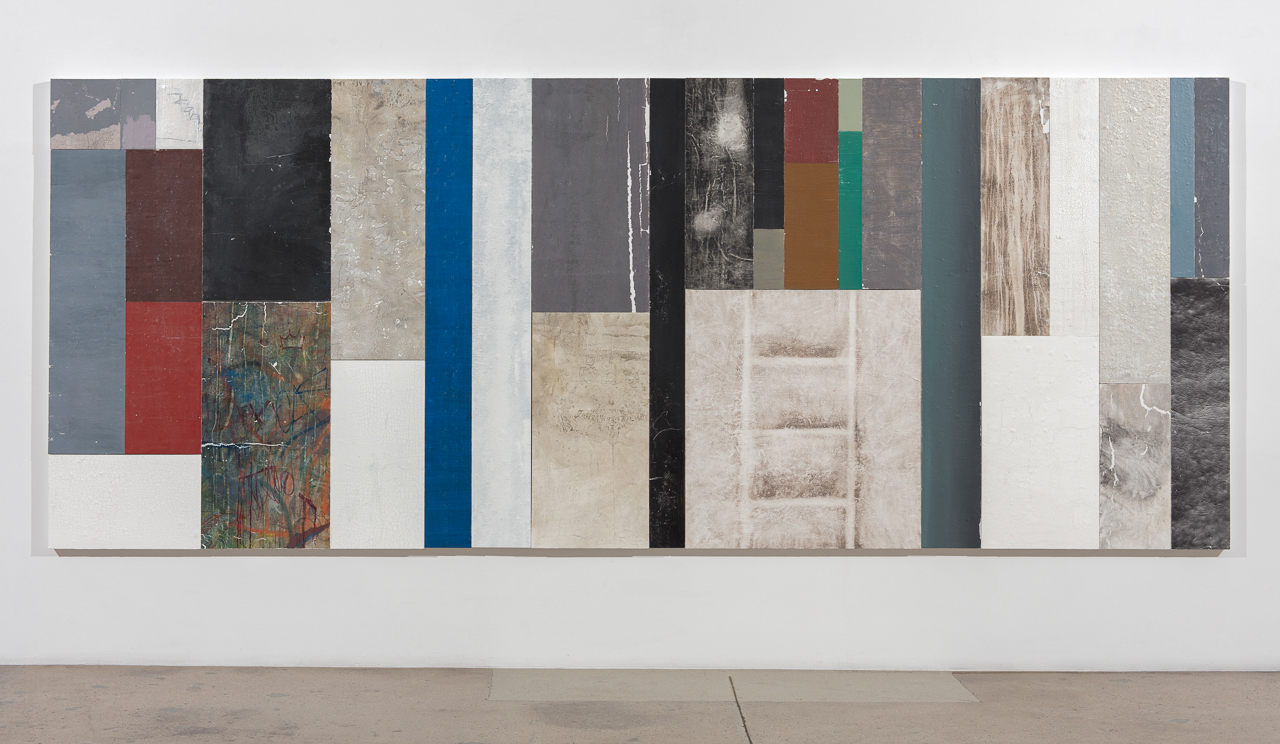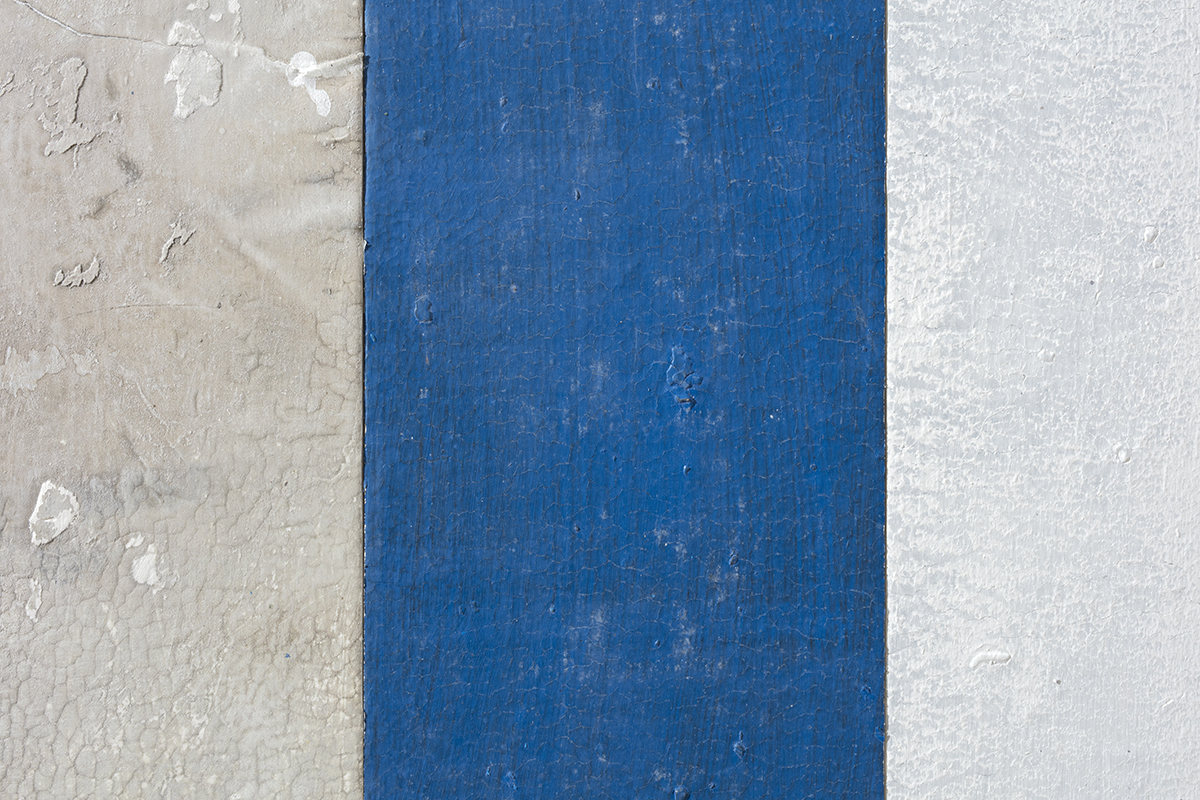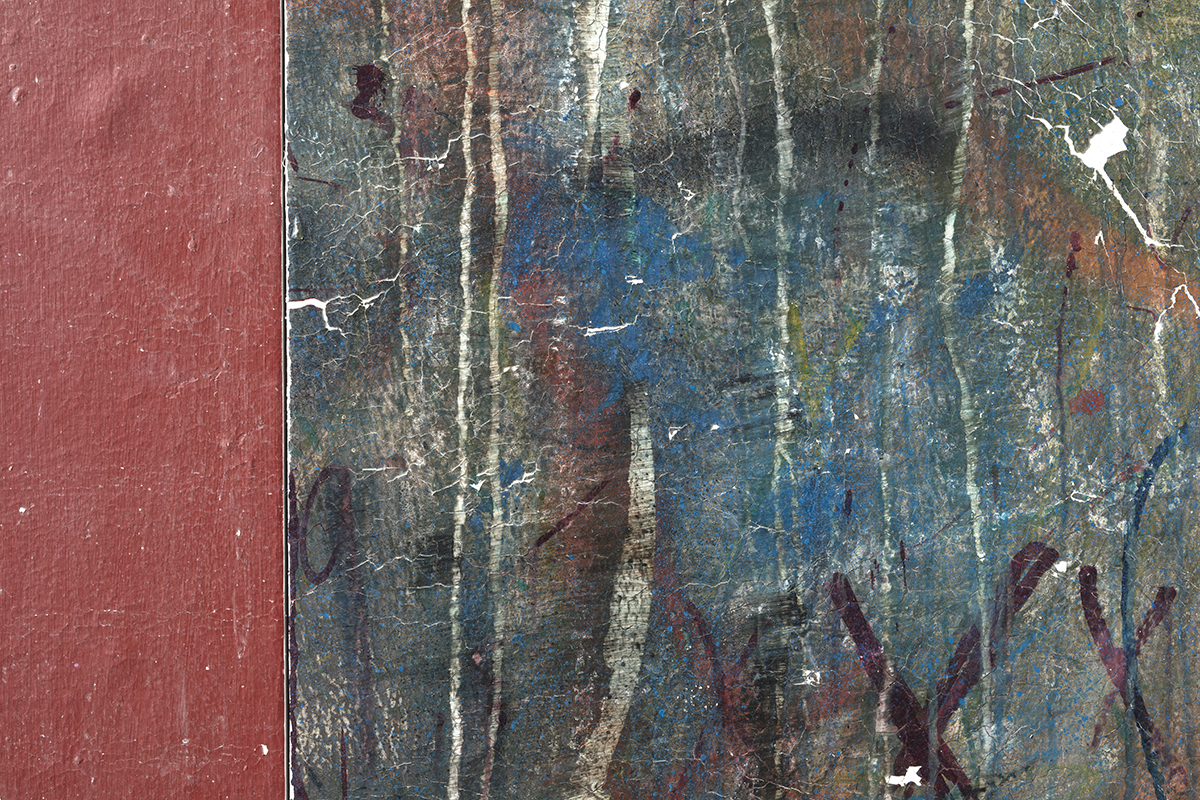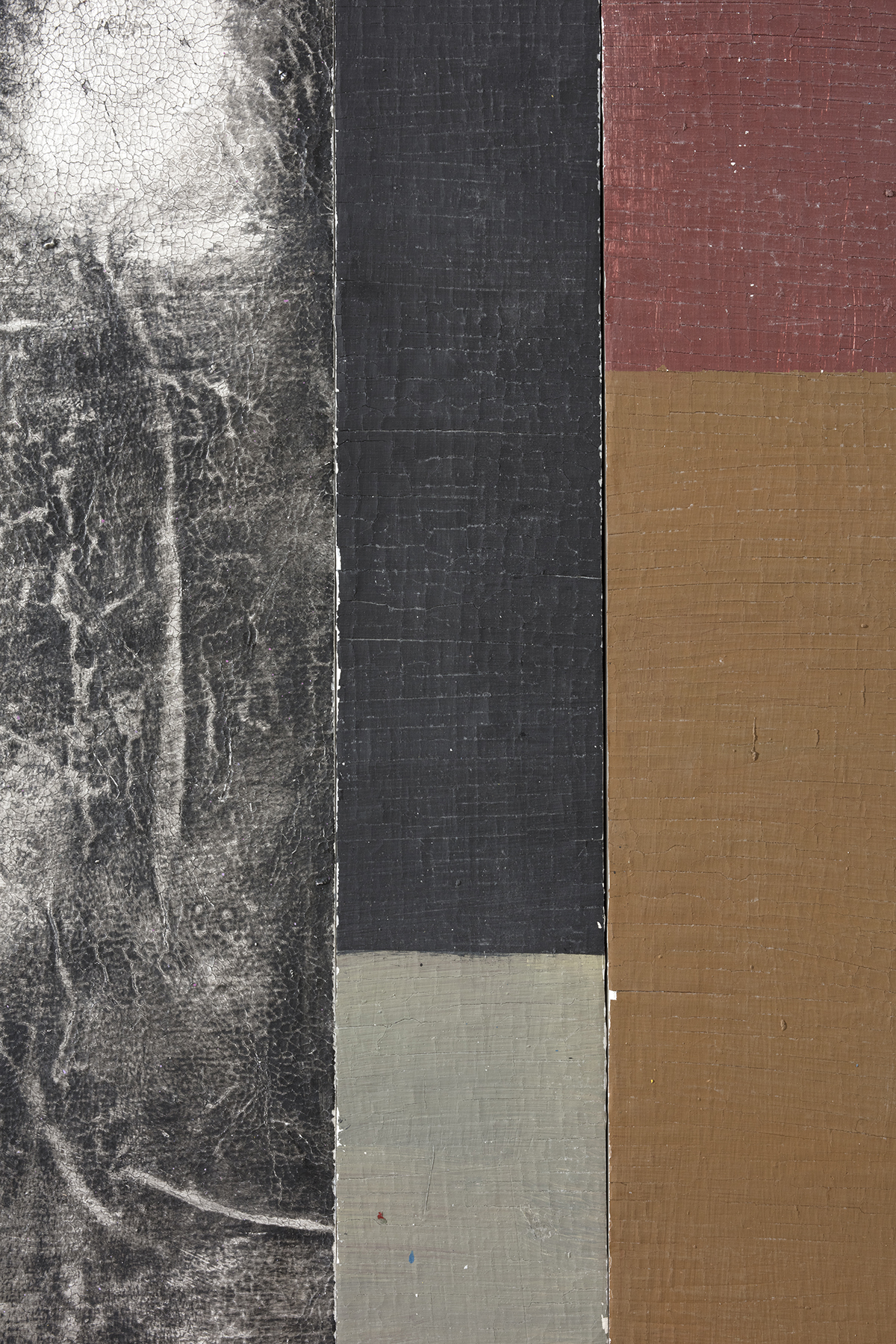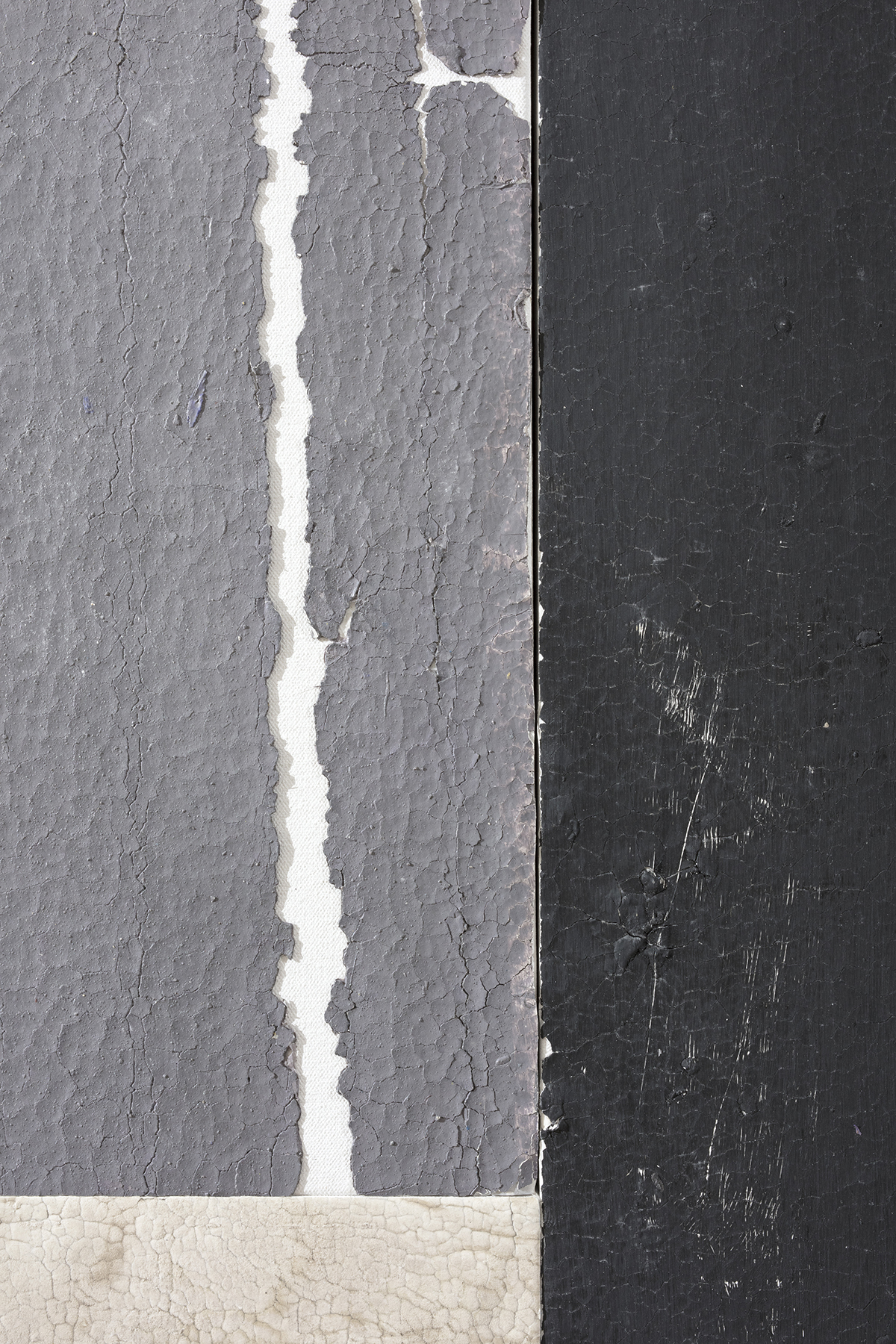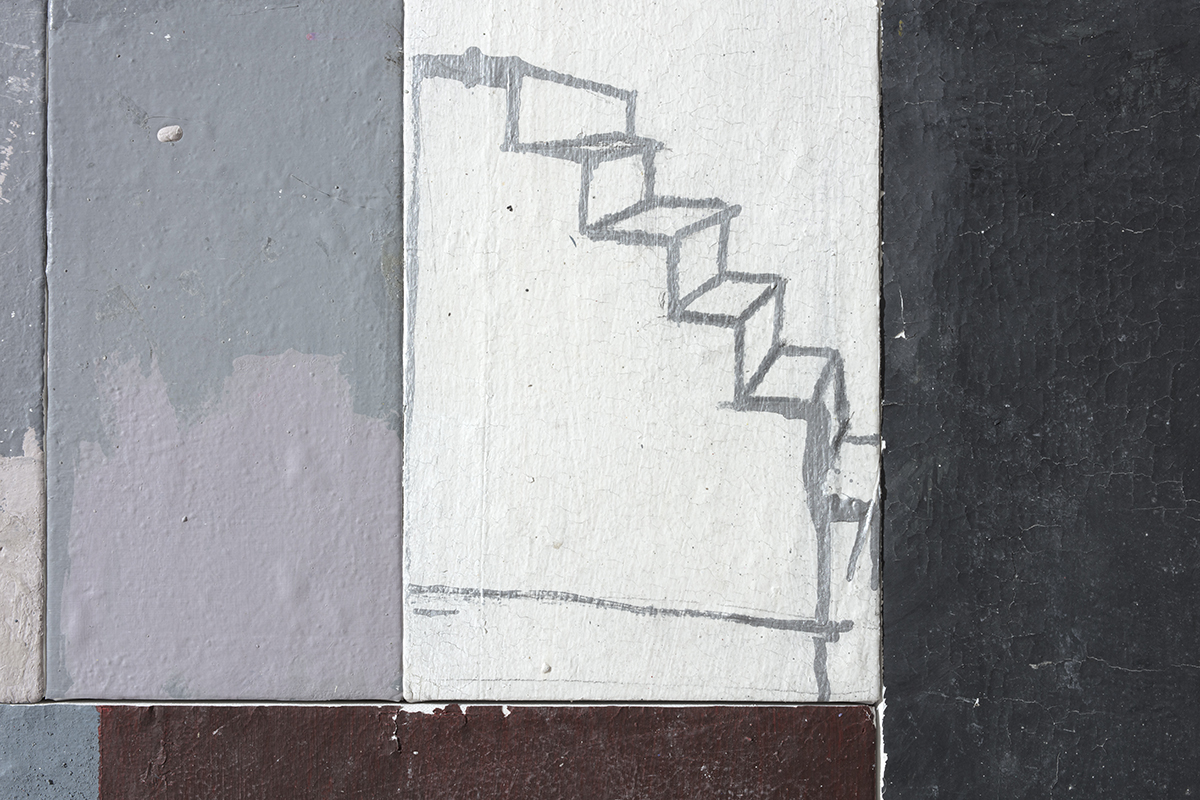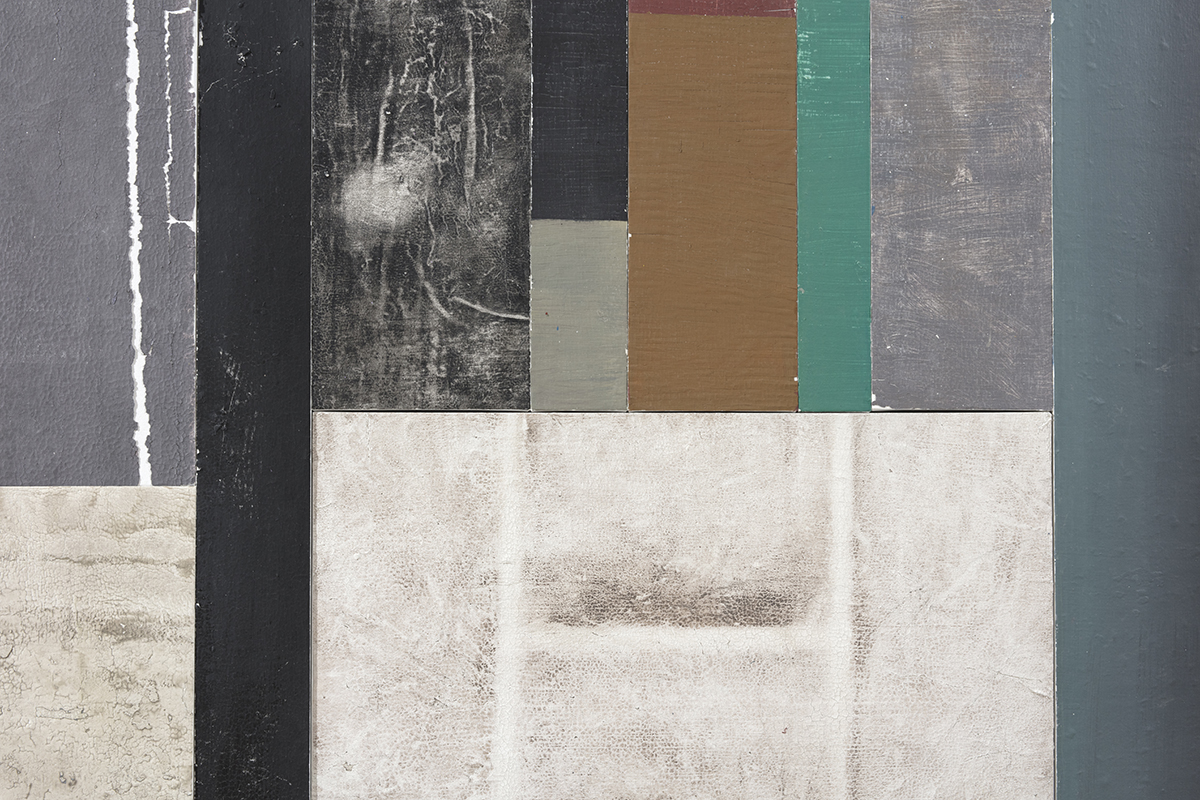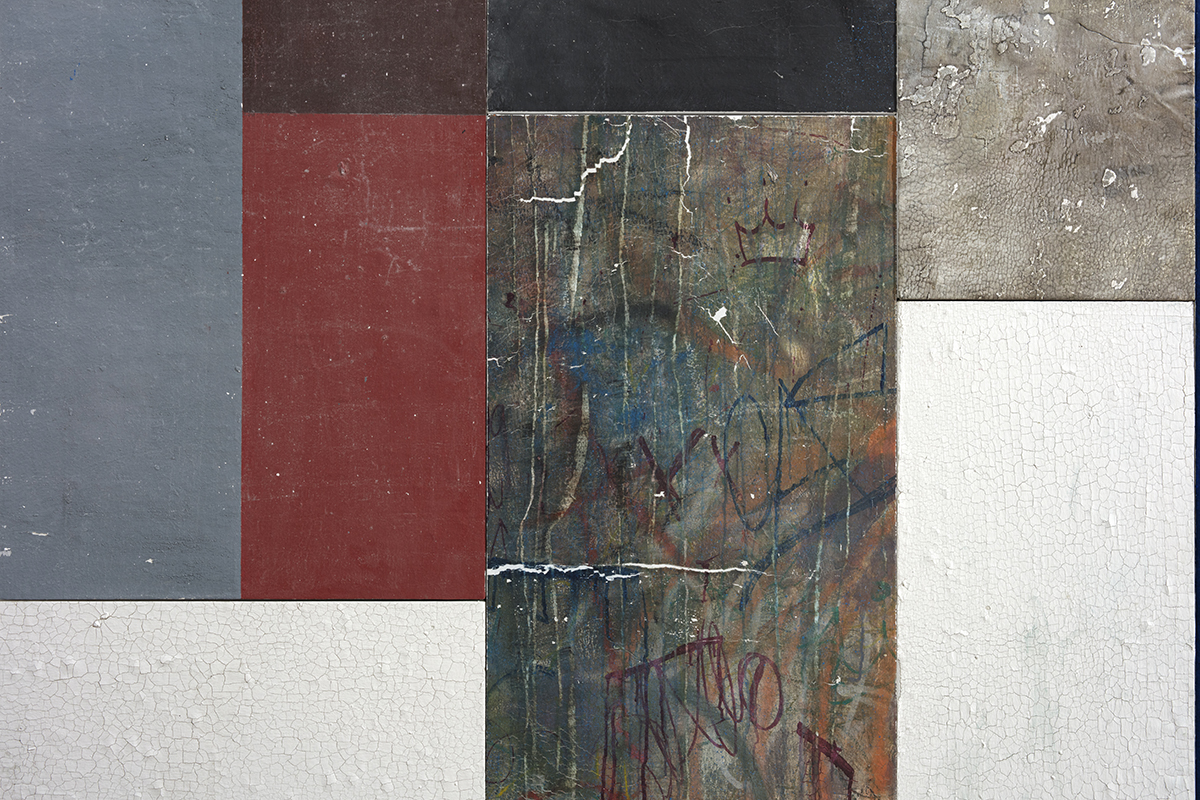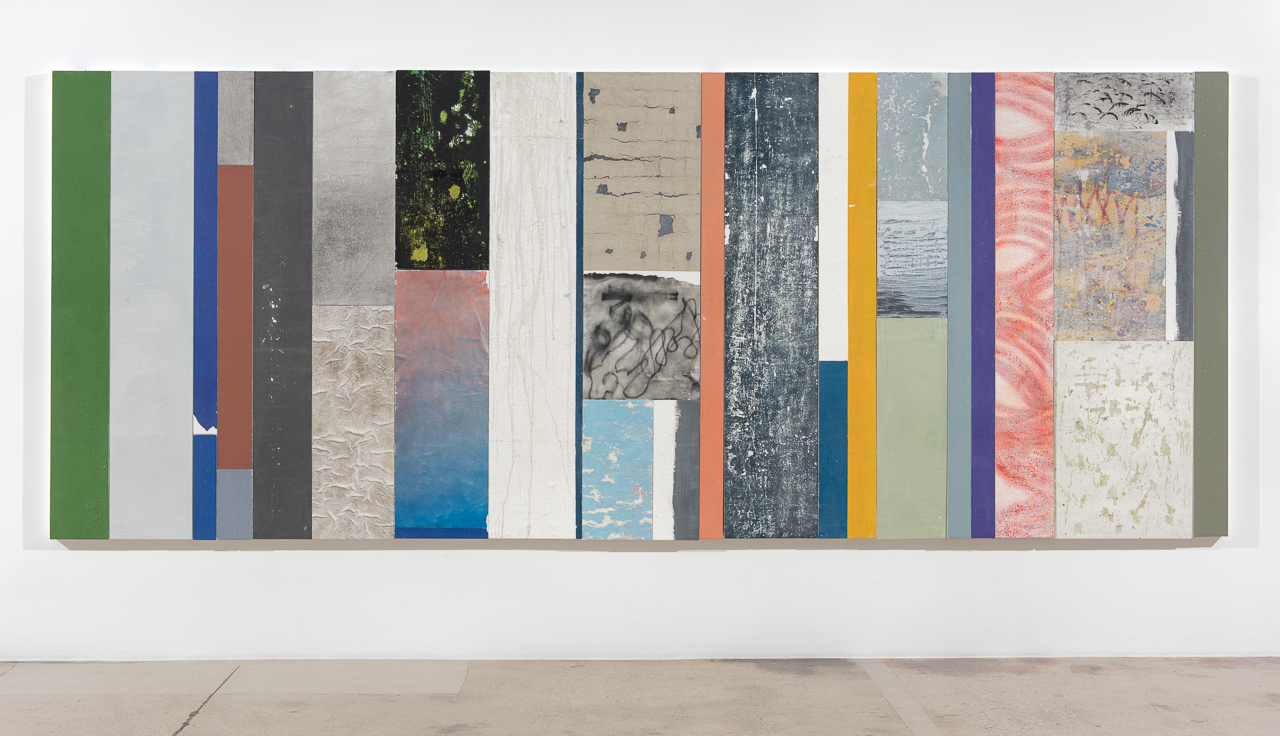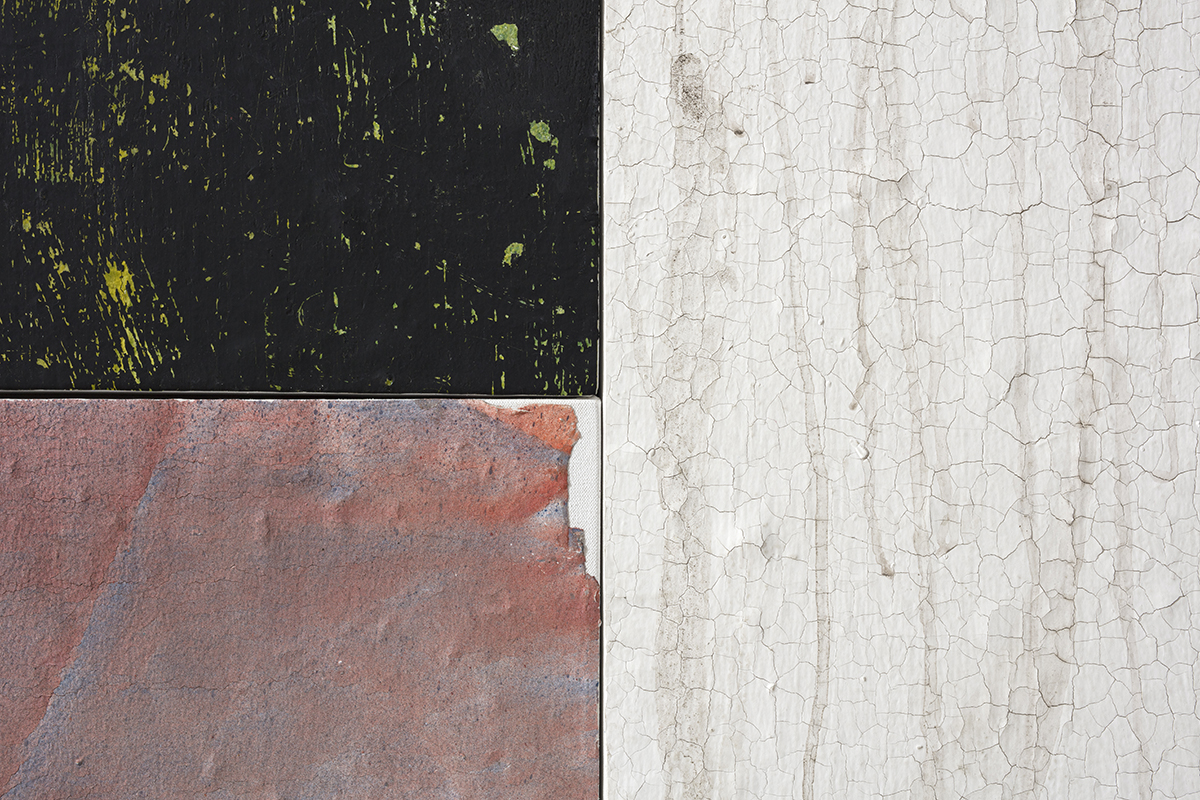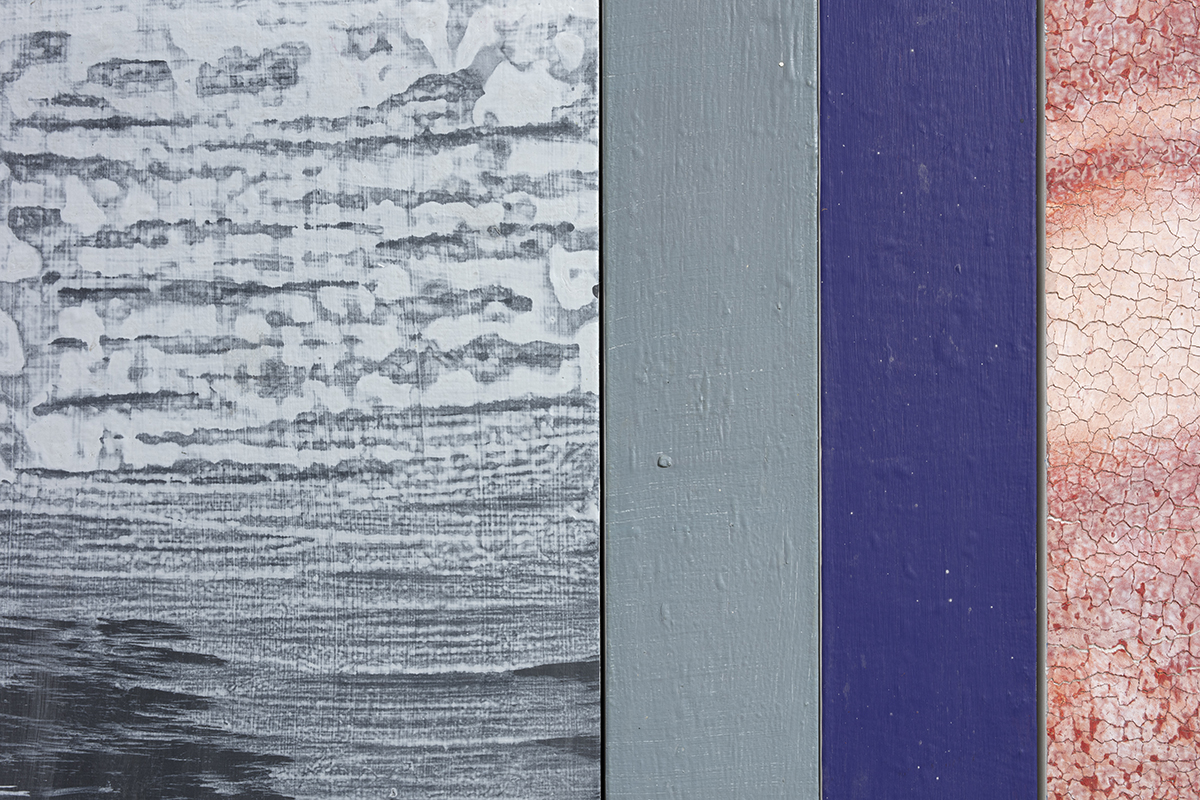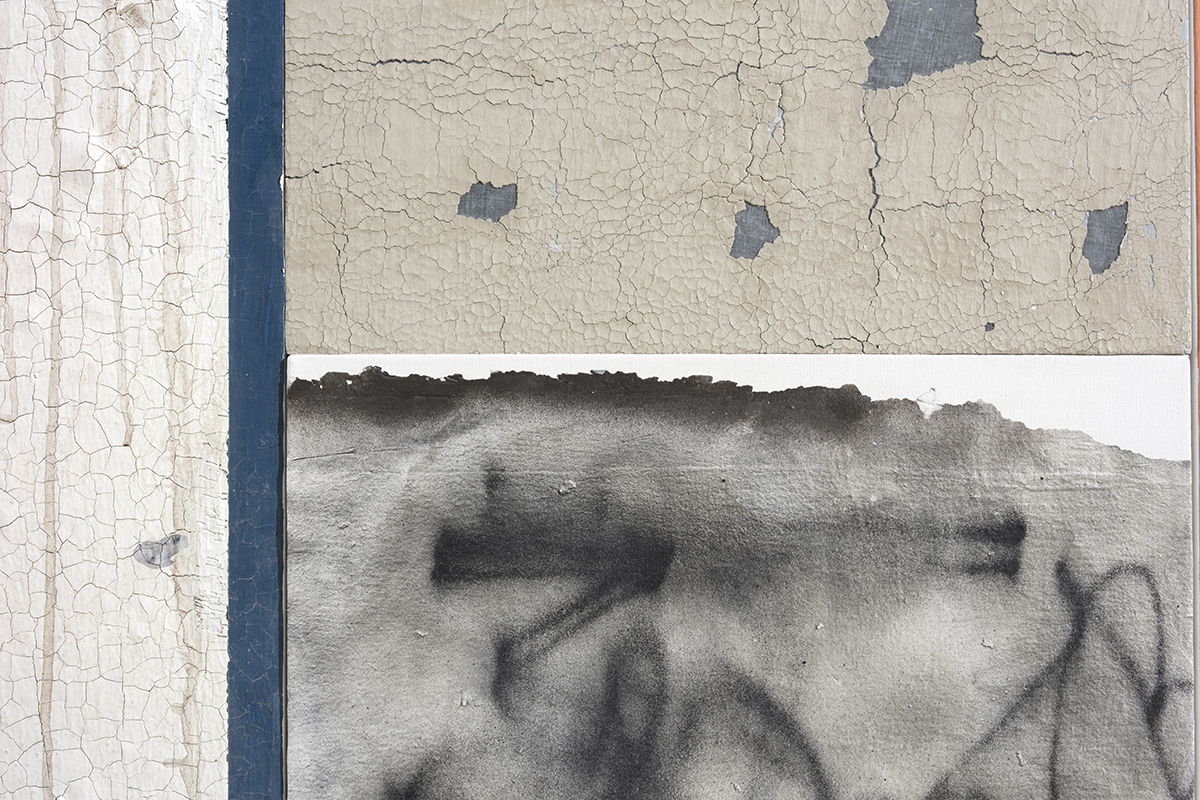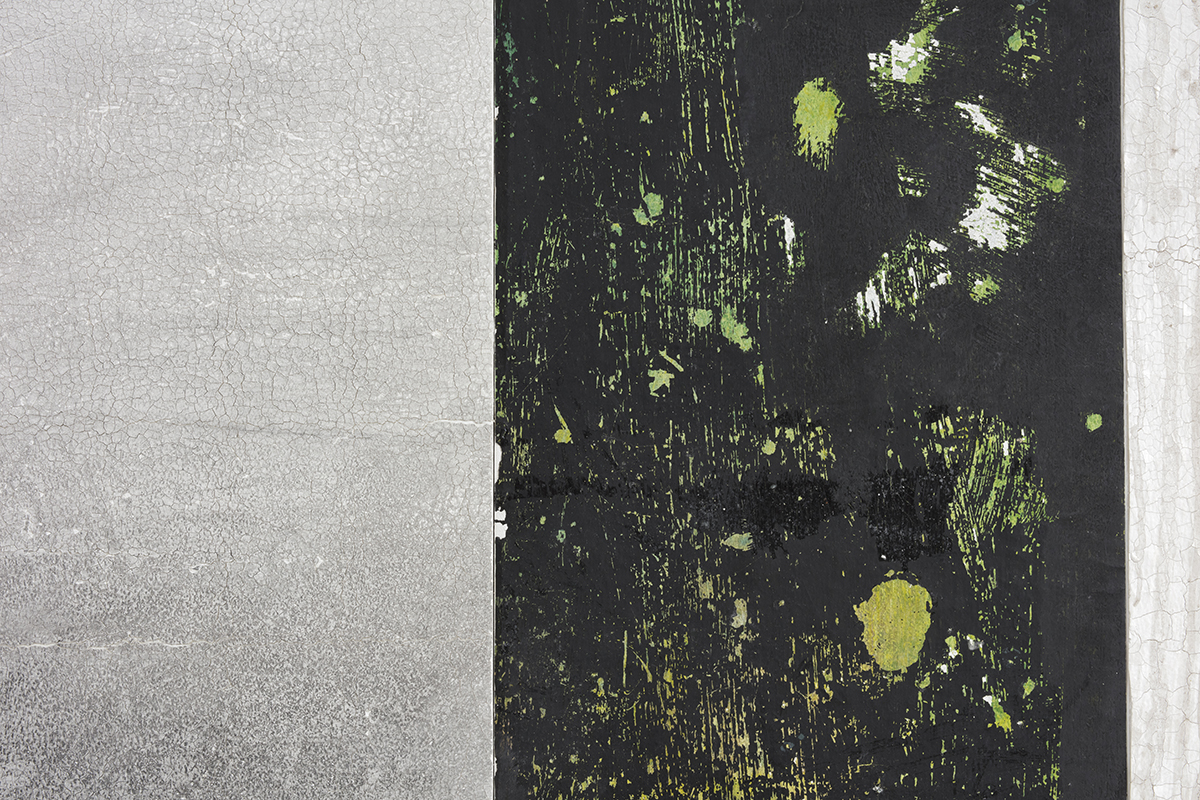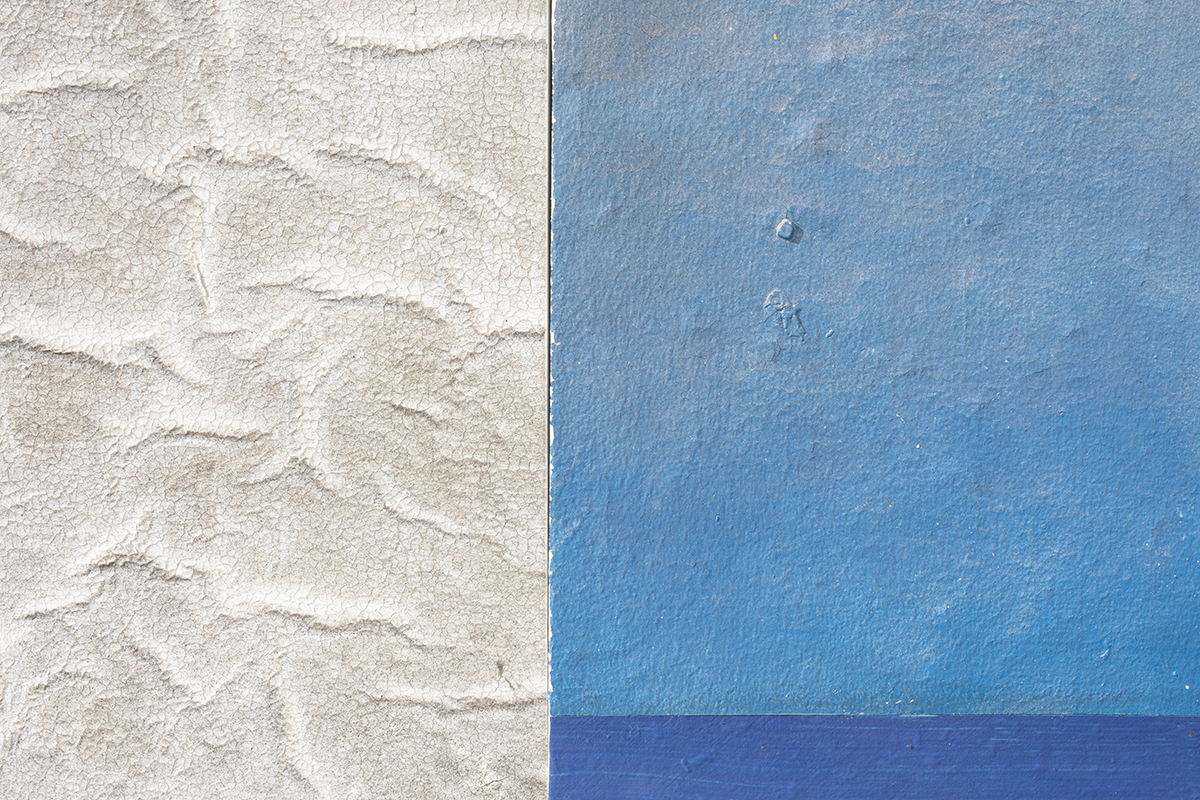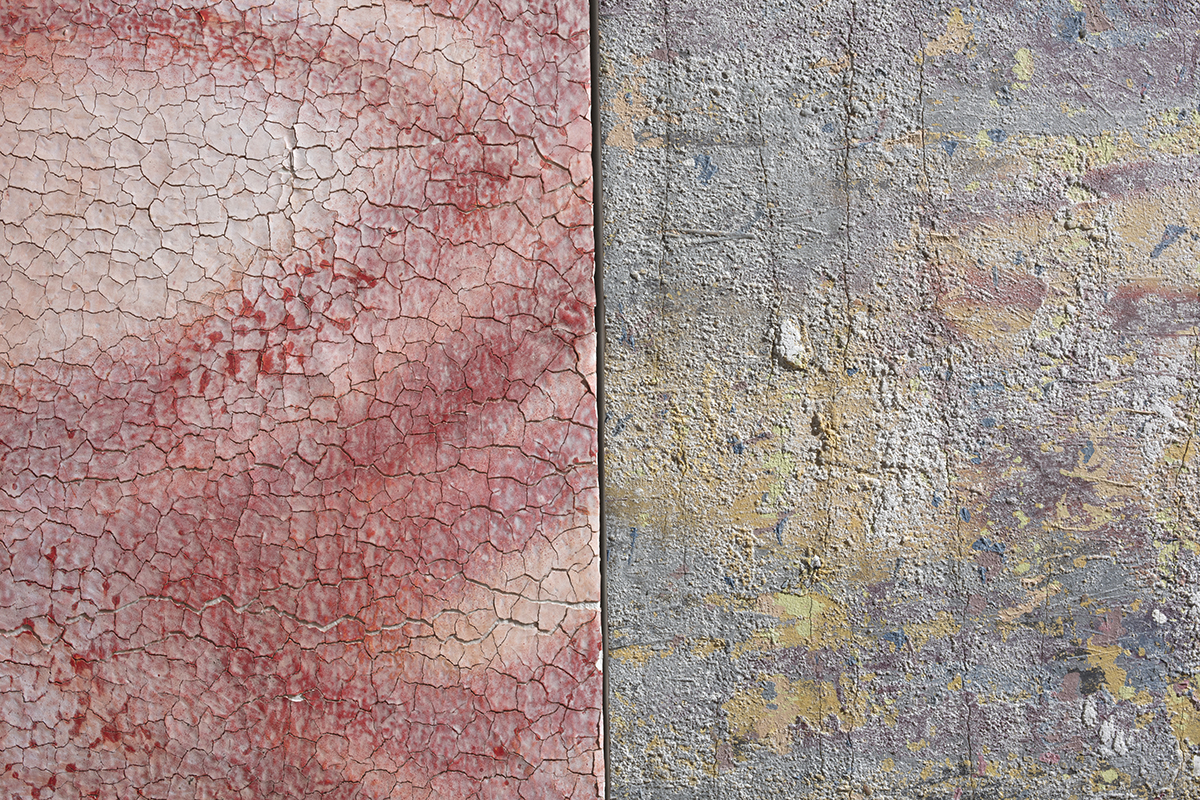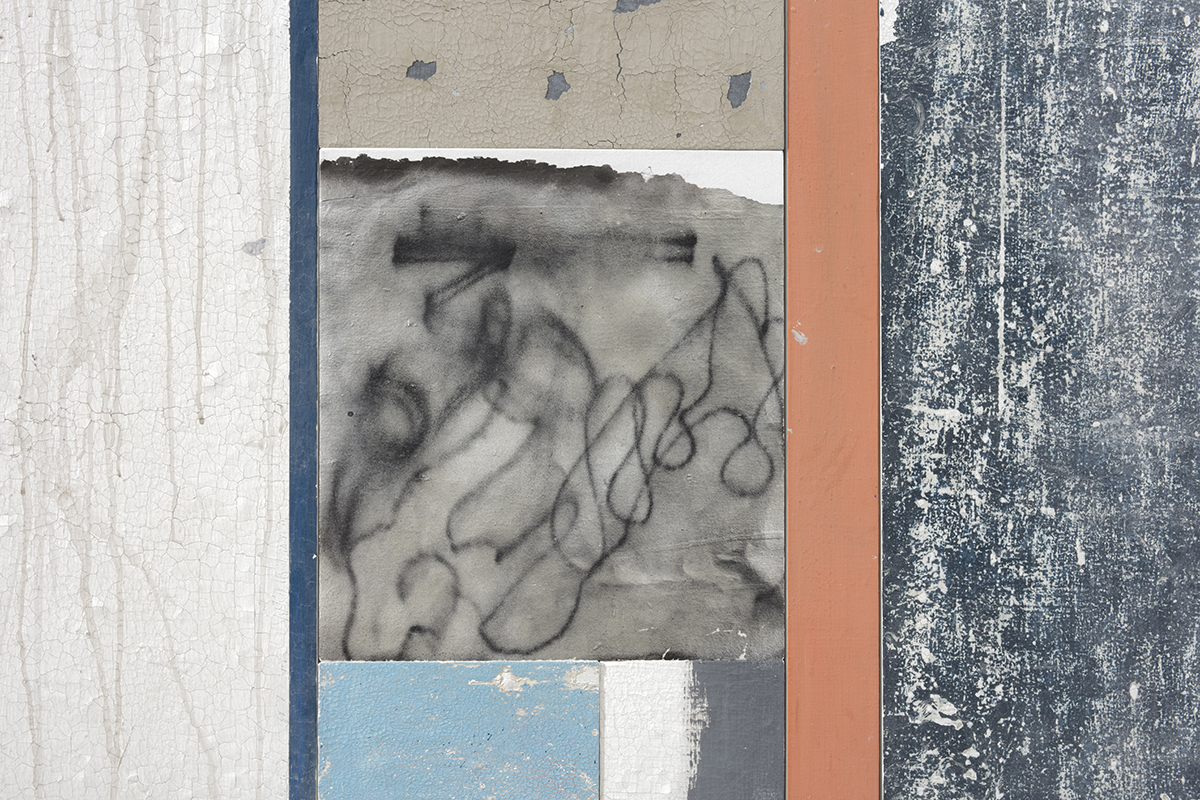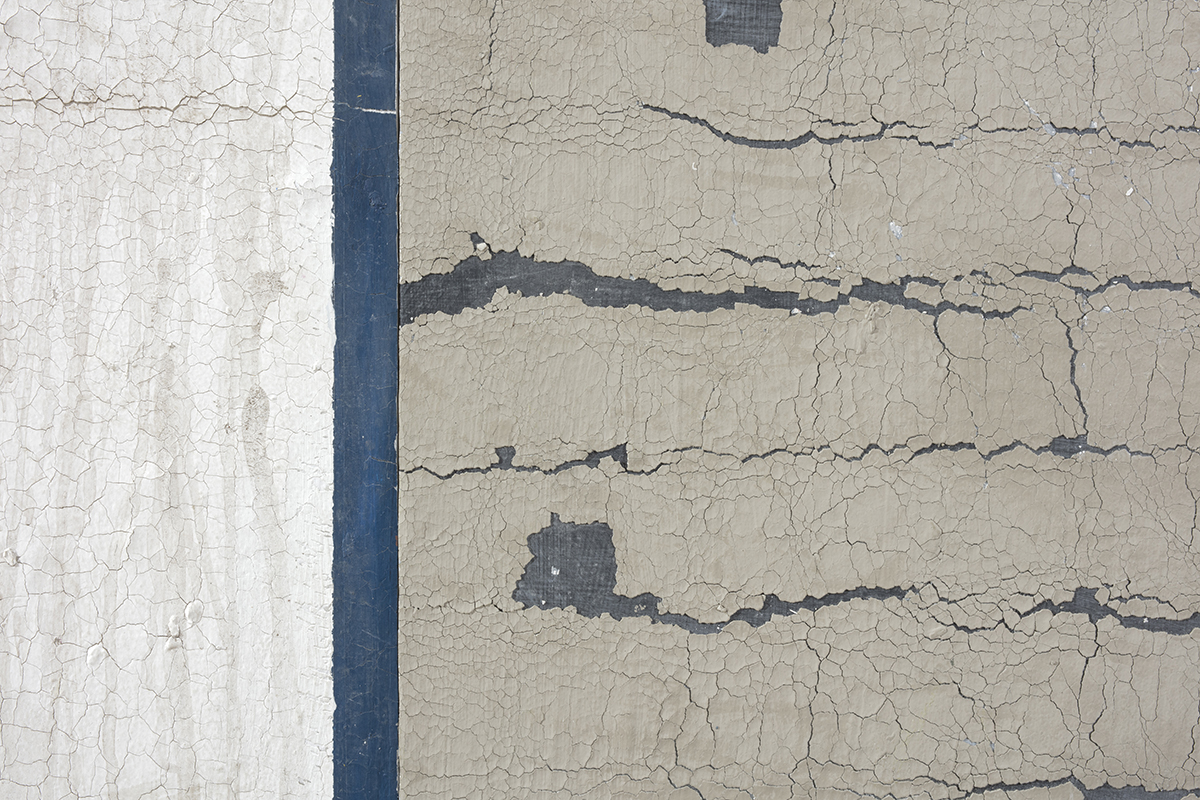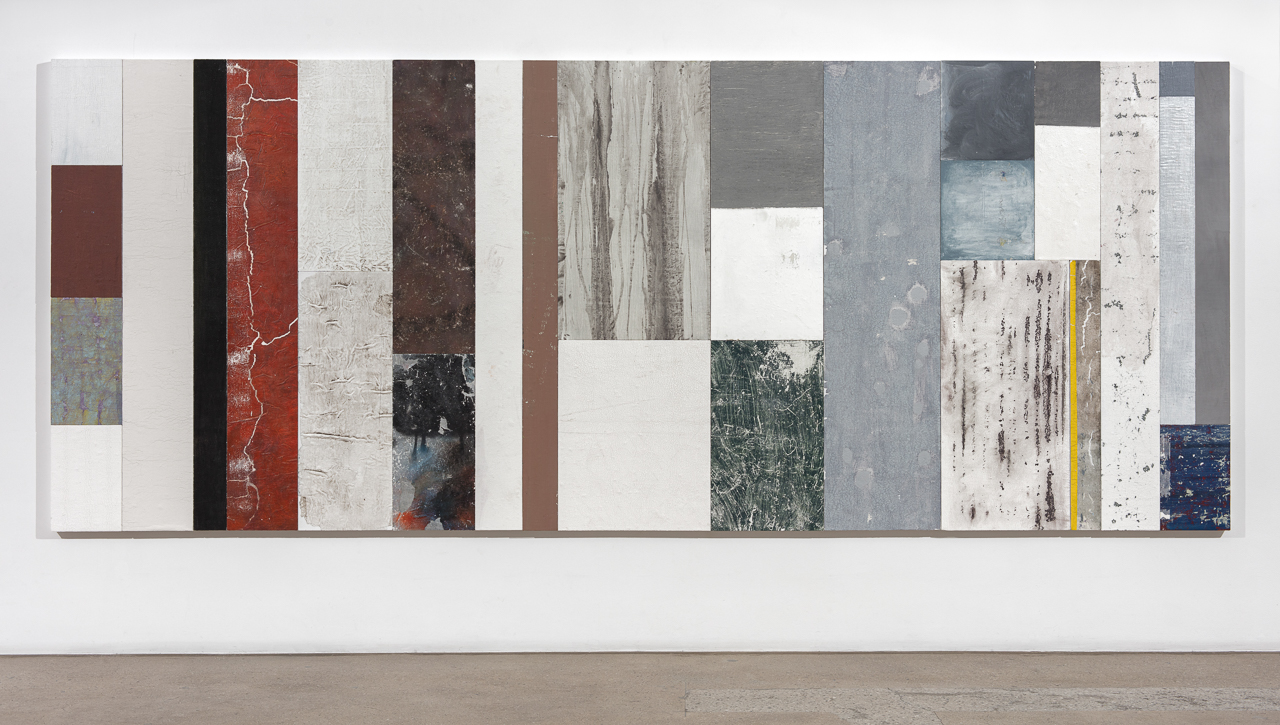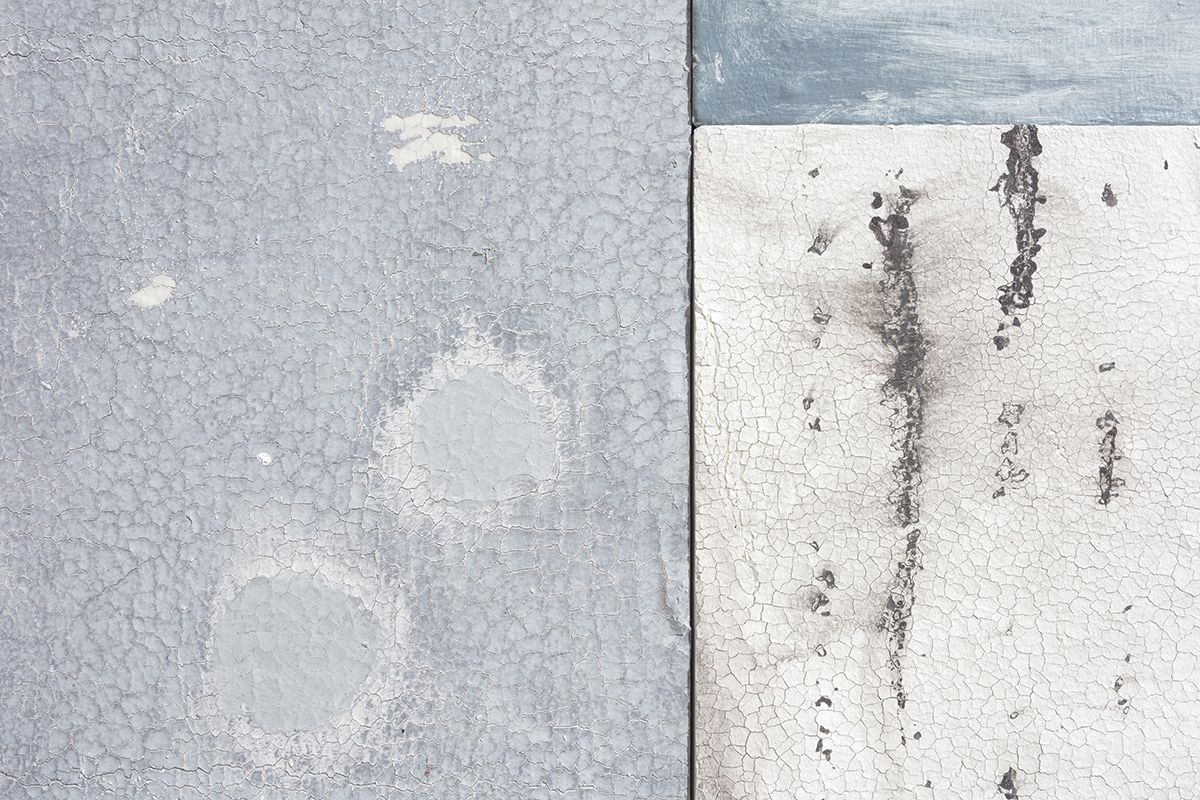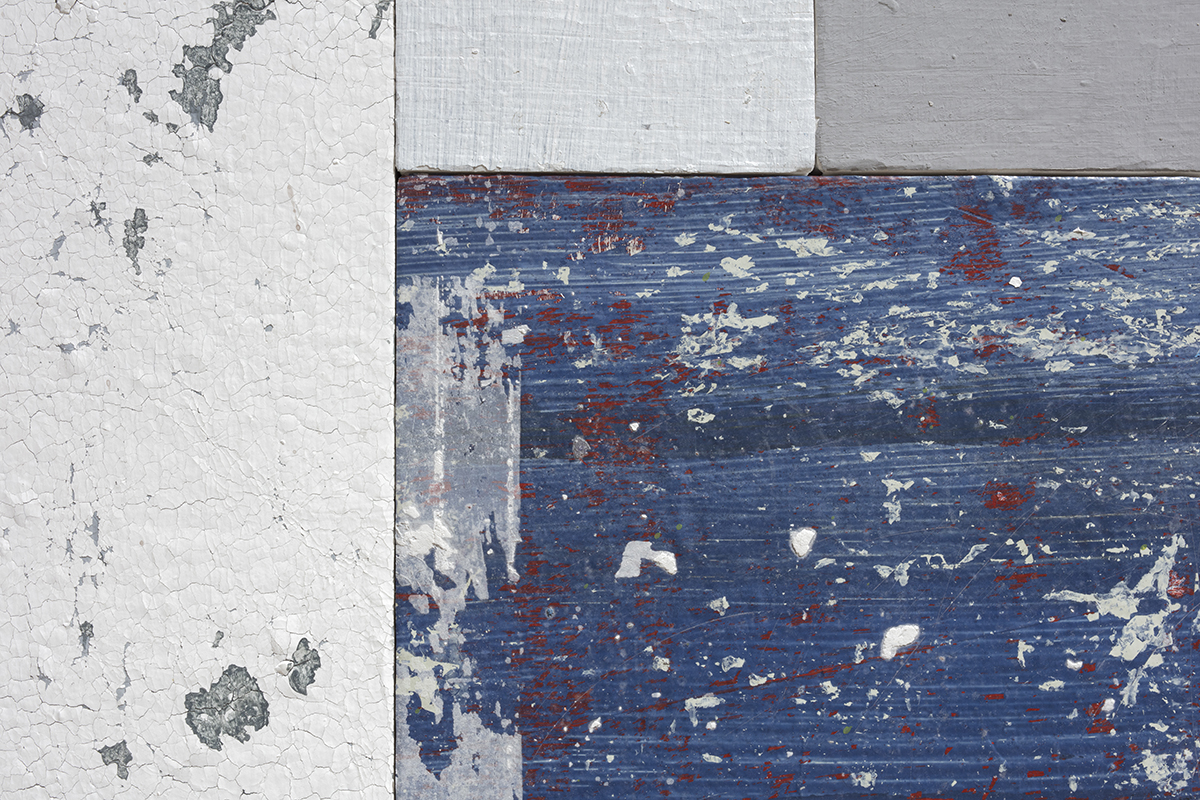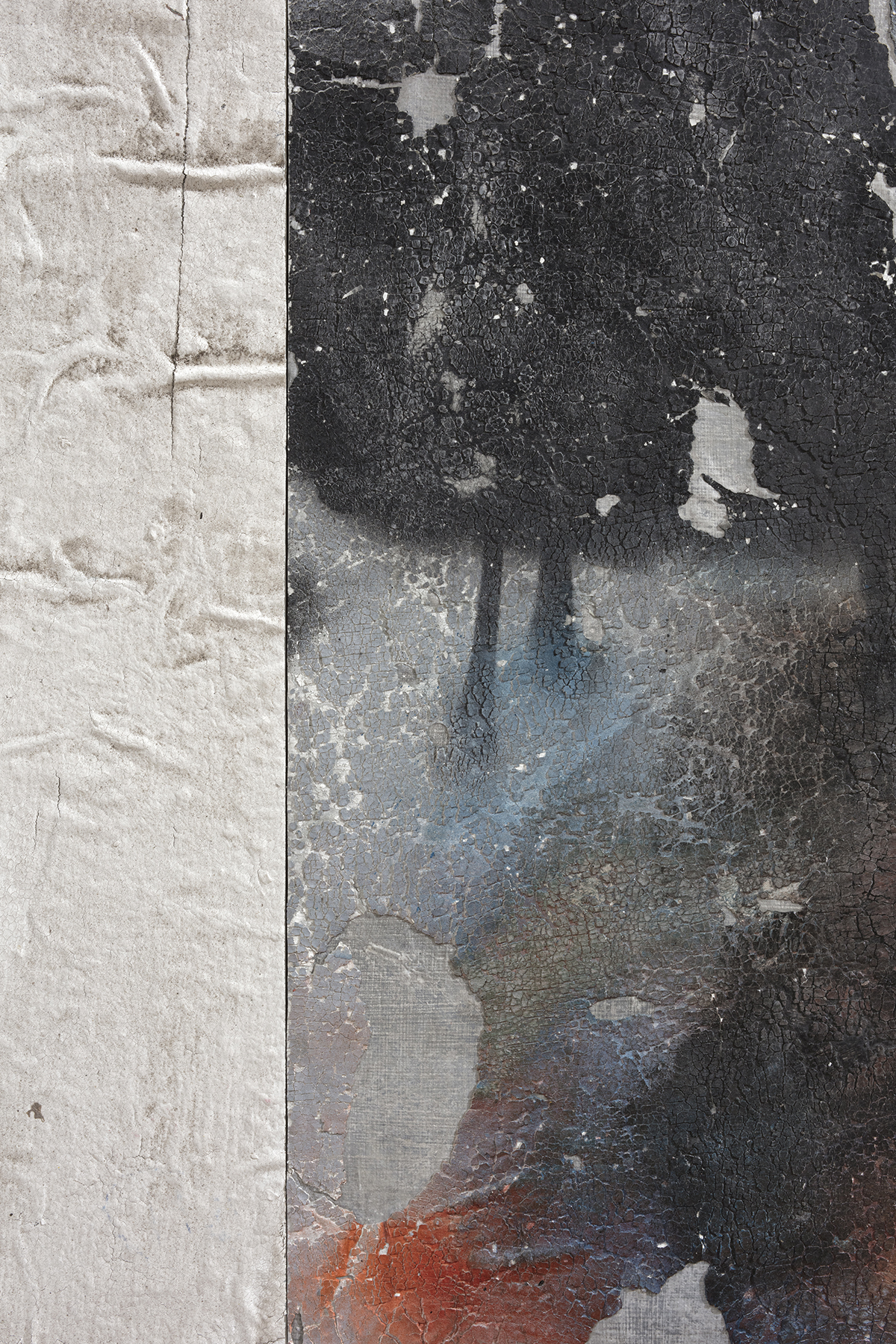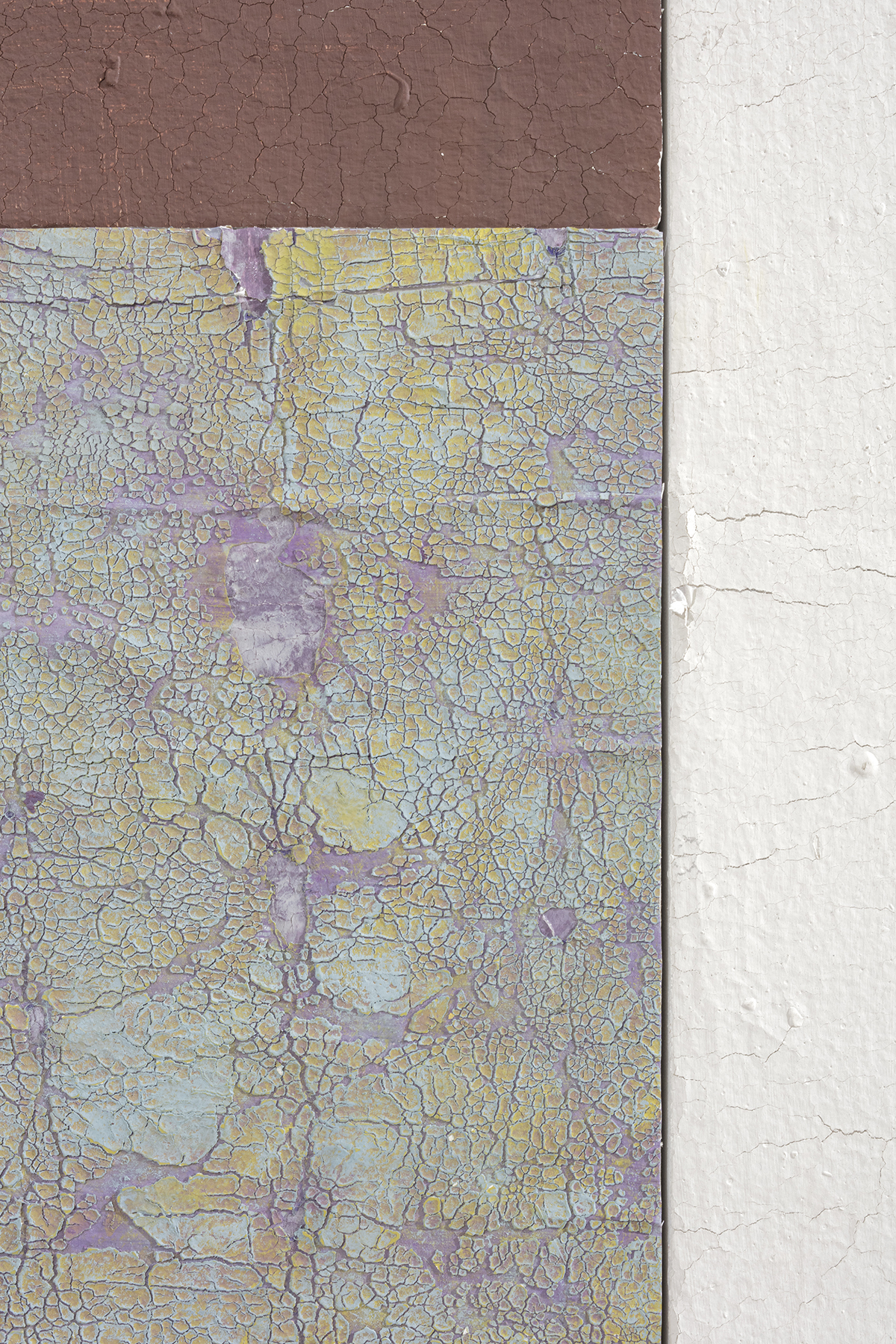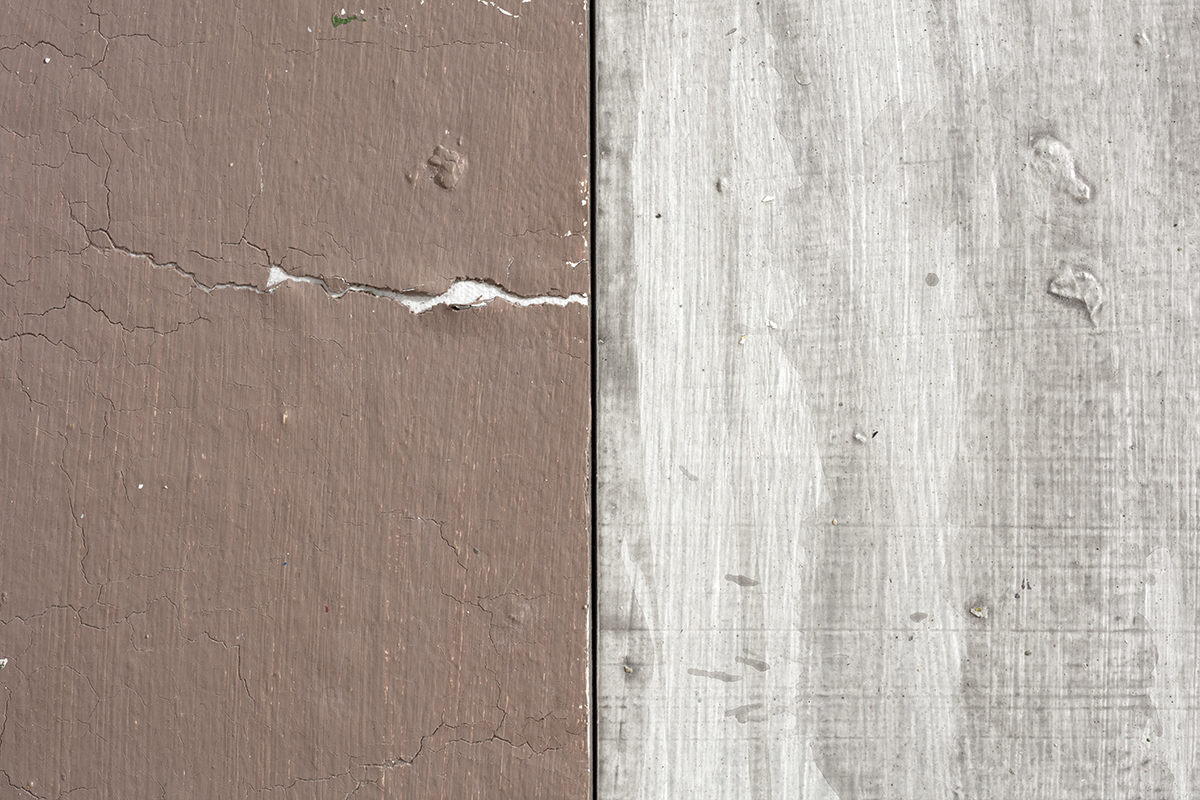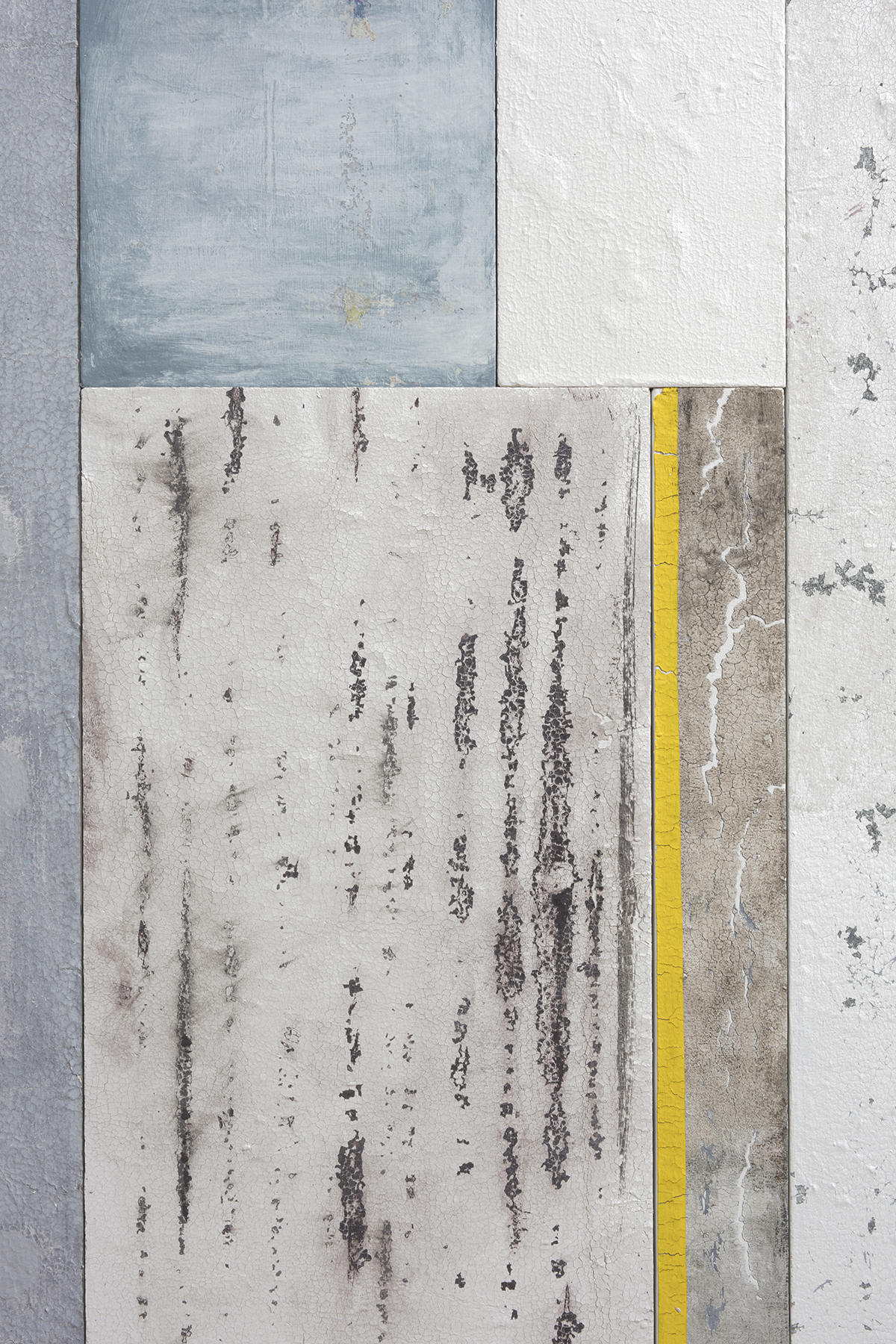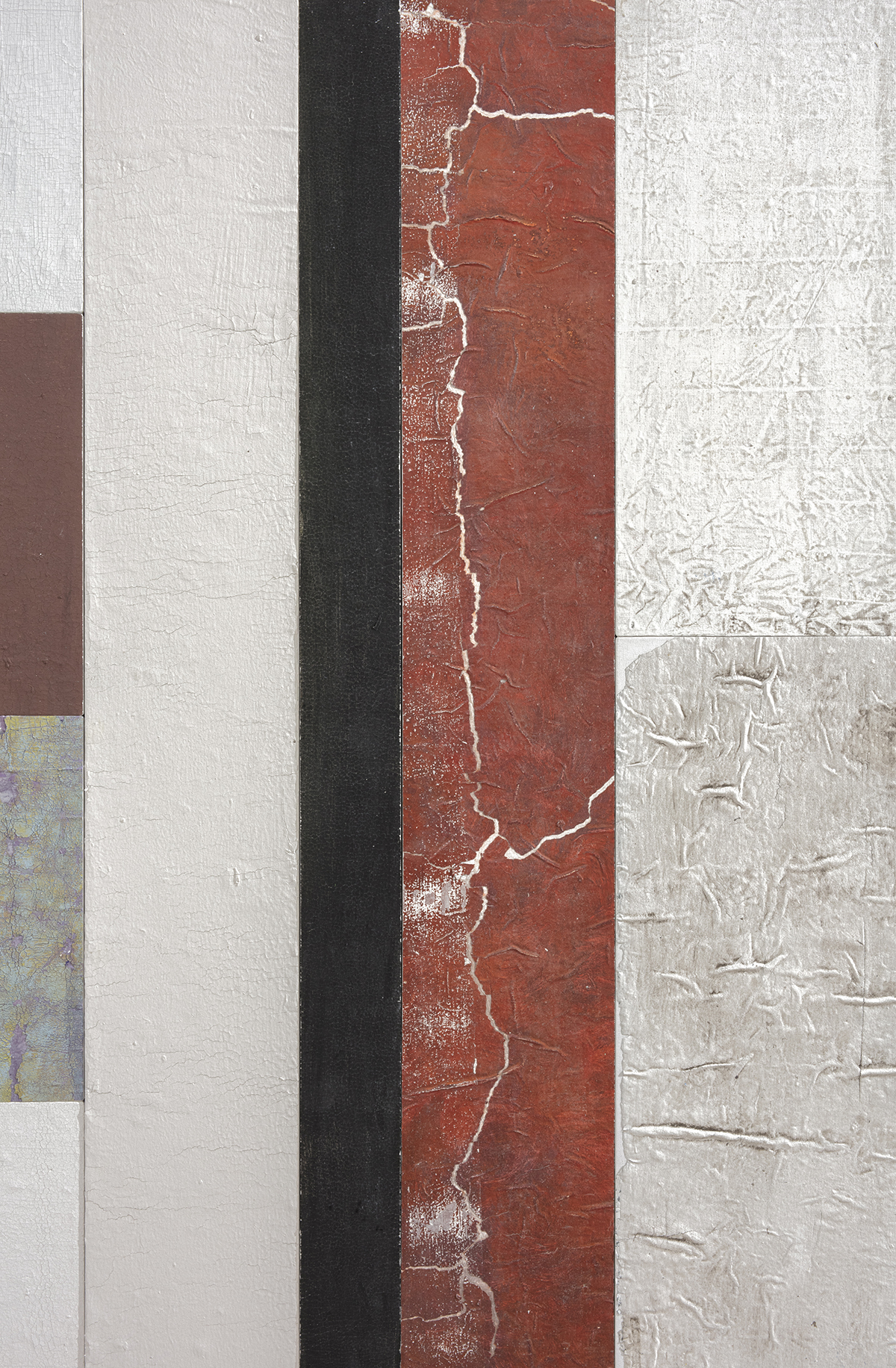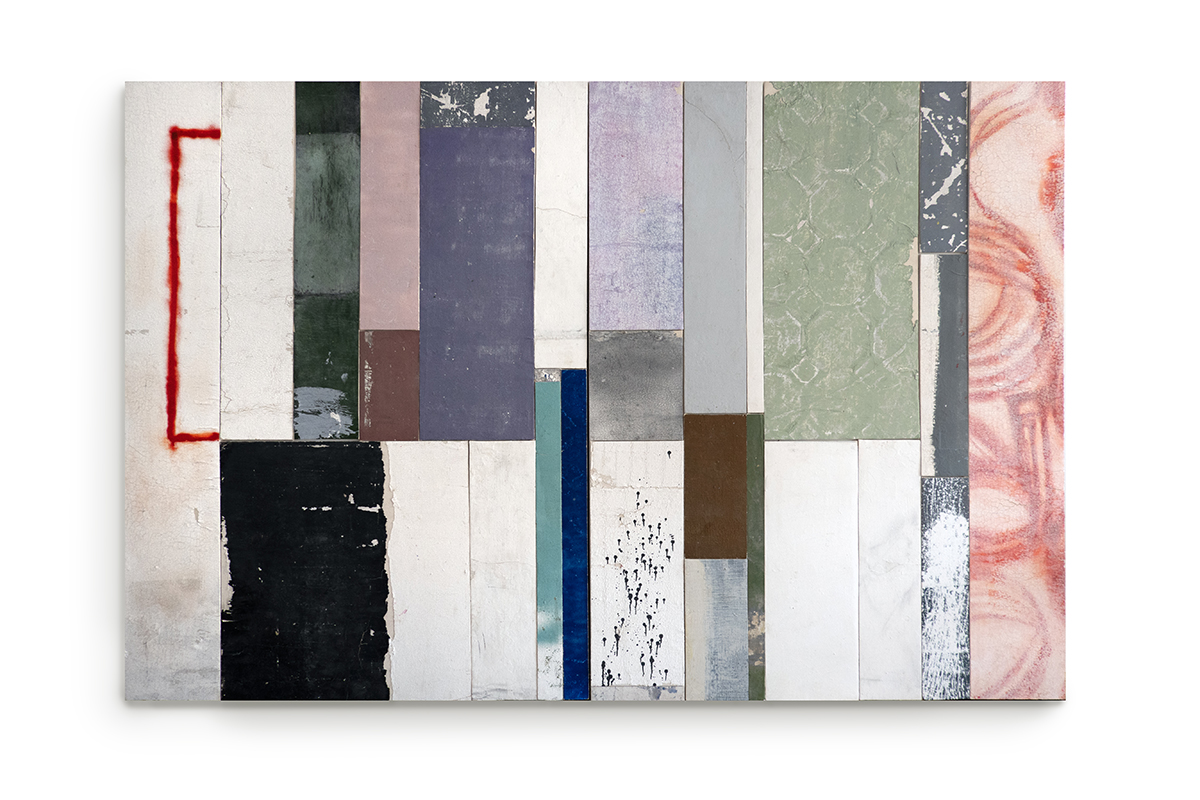Timescape
Timescape, consists of almost 200 paintings mounted on individual canvases, that Rasgado has removed from public walls around the world including Barcelona, Berlin, Brussels, Paris, New York, Philadelphia, Charlotte, Bogotá, Lagos, Los Angeles, New York, Tel Aviv, Ramallah and Paris, cities where he has worked for extended periods of time, and Mexico City, where he lives. The sections have been divided into sections, or chapters, but have been conceived by the artist as a single piece, to be installed side-by-side to produce a single work that spans more than 40meters in width and almost 20 years in time so far.
In utilizing the Renaissance technique of strappo to extract painted passages in public space (originally developed to move frescoes from one location to another), Rasgado has created a new painting that functions as a literal landscape of the various source cities. By foregoing allegory or representation, Rasgado assembles a work that is both a record of specific instances of time, place and circumstance and also an evocative image with multiple readings.
Materials
paint fragments removed from public walls.
date
2007-2025
Exhibitions
⎖Oregon Contemporary, Portland
⎖Fiac, paris
⎖Steve turner la
⎖Proyectos multiproposito, Cdmx
⎖Molaa, Long Beach
Collaborators
⎖Rachel adams, curator
⎖Enrique Giner, curator
⎖Gabriela Urtiaga, curator
Texts
⎖Rachel Adams
⎖Jorge solis arenazas
publications
⎖Constructs, CIR4 Exhibition Catalogue, ed. by disjecta
⎖Timescape,
Ed. by Beau Dessordre Press and Steve Turner LA
Texts
Published at:
⎖Constructs, CIR4 Exhibition Catalogue, ed. by Disjecta
Constructs begins with the wall. Through the varied artistic processes of Nathan Green, Pablo Rasgado and Laura Vandenburgh, the wall becomes a forum for experimentation that highlights the architecture of gallery space. Neutrality within the gallery has long been a point of contention and exploration by artists throughout the last century. These artists include William Anastasi and his West Wall, Dwan Mail Gallery from 1967—an almost to scale painting of the gallery wall, complete with air vents and wall sockets.
In his 2003 works Changing Space and Self Destructing Wall, Jeppe Hein altered the gallery space with movable, self-destruct-ing walls. The artists included in Constructs further this tradition of engaging the wall as surface, object, and partner in the making of their work.
Constructs adresses the interactions between scale, architecture, and the body specifically within the Disjecta exhibition space. Laura Vandenburgh’s netlike constructions reference each other in pattern and color, exploring the specific relationship between wall and floor. They expand, contract, and breathe —allowing abstracted visual fields to materialize through the reflection and refraction of color. Nathan Green adopts the wall as his canvas, employing blurred roller technique to explore pattern and geometry on an expanded scale. Green’s painting technique is affecting —it instigates tension between the wall and the remainder of the space, and challenges the very intent of the architecture. His wall paintings cross the influences of Modernist painters such as Sol LeWitt and Frank Stella with patterns found in Op-Art, labyrinths and textiles. Pablo Rasgado mines the historical significance of structures by collecting various wall fragments on his international travels. Each artifact carries its own history that is then adapted through the artist’s own interaction with the site. His new work for Constructs is a collaged mural of the substrates he has excavated from walls throughout the world.
The examination and deconstruction of the wall and the creation of new work are intimately tied in this exhibition.
The empty gallery is an elastic space, one that is in a continual state of flux.
Constructs examines and adds to this flux through each artist’s site-specific work.
The artists come together to build a “new” space that is the unification of painting, sculpture and architecture.
Published at:
⎖Timescape, exhibition catalogue
Ed. by Steve Turner LA
Our lives are a constant production of prints. Every story begins and ends with the persistence of traces. Even so, what is stirred under the subject is reduced to the sphere of signs. The story of the signals is confused with the story of the movement —and wastages— of materials; it integrates questions that contain changes in roles and processes exalted and forgotten simultaneously. Our gestuality is enclosed in the staging of matter.
In this intersection is where the pieces of Pablo Rasgado emerge. His process, based on the technique of strappo, begins with the detachment of different surfaces of walls in places where he has worked, both his studio in Mexico City and Portland, Chicago, Quebec, Tel Aviv, Nigeria, Paris and other places. Later, he makes montages with these fragments, and disposes new orders that point to the pictorial tradition, extolling the color values , the rhythmic patterns and the textures, but without gird of her. In this way, he reminds us that abstraction exercises don’t start properly in the field of painting; they precede and transcend it.
Similarly, the pieces can be related to the collage, but their operations are different. These are devices that are not exhausted in their object-level and whose visual range is tested; one of their premises is that the painting is larger than his dimension “retinianal” to say it with the Duchamp’s term.
Timescape – the biggest piece measuring 5×2 meters (197x 78.7 inches) was made with landslides collected between 2007 and 2015. In it emerges a problematization that still in other moments of Rasgado’s work: the permanent tensions between matter and memory. In this particular case the investigation started questioning the origins of the materials and their ability to establish new continuities. Being stripped from the walls, the fragments are released to join a new relational margin. Before granting them a different framework, the artist transforms his three-dimensional condition into a two-dimensional structure. This reduction is like the one that does the microscope in laboratories, by constraining walls fragments, it achieves amplify the wealth they contain. If in their original architectural units don’t occupied the foreground, here their properties are underlined; they attend history that, in a biased way, recreate and the information involved jumps to the scene. Inside the exhibition space, landslides seem motionless, but this stasis is only a deceptive appearance: each surface is vestige of a flow, sign of other routes. That’s why it is not only about trouvés paintings. It bears repeating: they are devices that allude painting, but questioning and relativizing it.
In this sense, his attempt is no stranger to the muralism that also expands its construction beyond the image, involving architecture and other extra-aesthetic references. Siqueiros not only was committed to a political narrative and ideological discourse, but also with matter exploration, in such a way that, in his work, these levels form an amalgam (just remember his resistance to the fresco painting). In his terms, it is impossible to set a new aesthetic language —and the correlative criticism against an order of things— if it is rejecting the material possibilities (hence his interest in piroxilina , a substance found in the automotive industry).
For Rasgado, the muralistic work doesn’t depend exclusively of the large format and the public context. His formal search also begins by a material exploration, from a residual level, but without falling into the collection and recycling in the sense of Mario Merz, Yannis Kounellis or Luciano Fabro. He is concerned about the matter because his conditions, according to their own history; in such a way that matter becomes the first comment of the work to put in tension with its space-exterior. On the other hand, the artist doesn’t avoid the political status of the mural, but reverses its values and references. What other way to understand his insistence on conceiving painting and architecture not as independent entities but in indissoluble reciprocity?
These scans, at the same time, have an actual landscape dimension. This landscaping doesn’t refer to an object or image, but the way we look. These pieces reflect not only on the production of themselves, but about the way we consume images, in a general sense. When operating by different fragments, they seem to remind us that in a world where visual syntax saturates all levels, the images are not there to be seen.
On the contrary, all social mechanisms -including us as spectators- have a duty to generate them in a steady stream. Therefore, our attention tends to descompose the objects and the bodies in details; the reality is something we see only in sideways. Landslides question just the look of this deployment. Viewing from saturation involves to be blinded for the characteristics and perceive, in a transient and discretion way, only accidental and imprecise blocks, which are the new landscape in modern cities.
When Antoni Muntadas conducted his Exhibition (1987) installation in Exit Art, he sought to appeal to the viewer through an absent image. His work triggered a formalism that extolled the space of representation eliminating pictured. He pointed a display device transformed in the presence of the refusal to submit images.
The Rasgado’s pieces reverse this logic. They do not simply propose unpublished visual sets for the areas extracted from territories where they tend to remain invisible and buried in functionality. Triggering other processes and forcing us to see what is out of the work; these rectangular formats cannot be observed at all they aren’t in relation to their otherness, which is one of its essential components. Each of these fragments works, in fact, as mnemonic and perceptual detonator against what is happening somewhere else. The image, therefore, is a kind of synecdoche. In the process, the work shows what precedes it, and we only noticed because of it. In the same vein, its components and the fragmentation are not just stylistic; they build a reading of the circumstances in which the work will be received. We can think in a common, even trivial, but clarifying example. An altar isn’t the same in a temple than in a living museum exhibit, not only because the semantic dynamics that punctuate and the vocation manifested at each site, but for the reconfigurations that experienced the physical layer. The light, the concerning color or the textures information that have tend to change and impose different ways of seeing.
Rasgado is aware of these changes and integrate them into his project, integrates themselves into a strategy. He hits the nail on the head by proposing a sort of migration of the structures that seem solid and stationary by definition. And in this journey, it’s clear that isn’t the look that surrounds the matter, but the opposite: waste, footprints, anonymous stories of objects and their strokes are those that outline the way we see and end up disarticulate the matter.
Jorge Solís Arenazas
Mexico City, September 2015
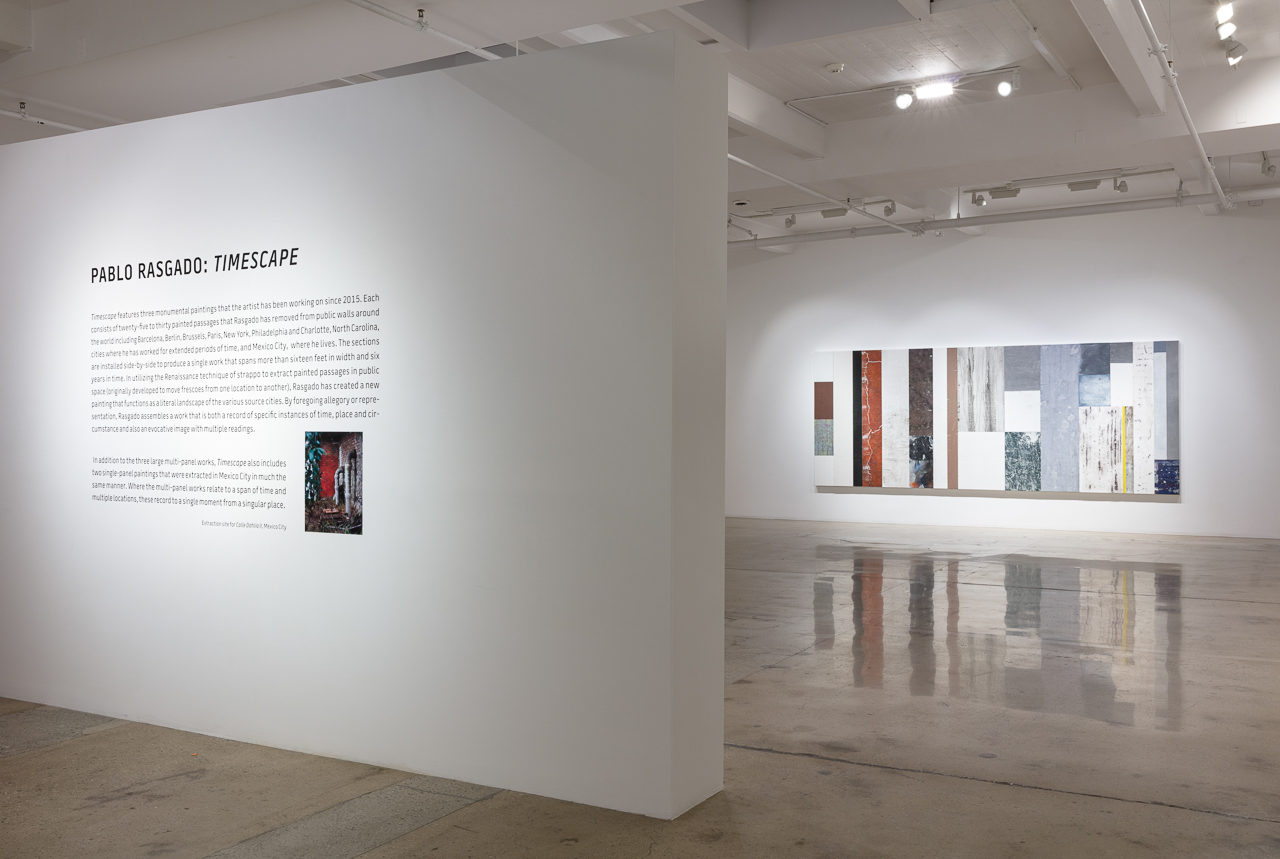
pablo rasgado, Timescape, 2007-2025. paint fragments removed from public walls. Exhibition view, STEVE TURNER. L.A, 2021.
Timescape
VENUE:
STEVE TuRNER, L.A.
DATE:
2021
no. 03 - no. 4 - no.5
title
TIMESCAPE
medium
paint fragments removed from public walls
DIMENSIONS
Variable measures
Vol. 6 (Ongoing)
Installation View:
Proyecto multiproposito
no. 06
Title
Timescape (Vol. 6) (ongoing)
DATE:
2021-
medium
paint fragments removed from public walls
dimensions
ongoing
projects
